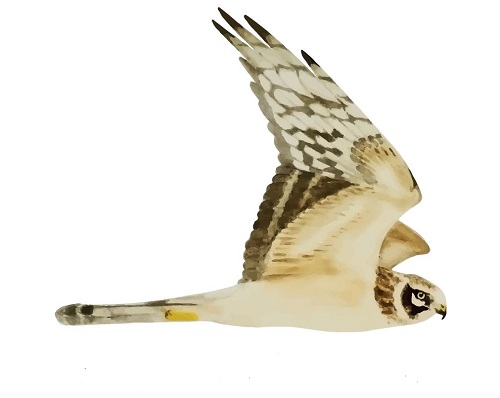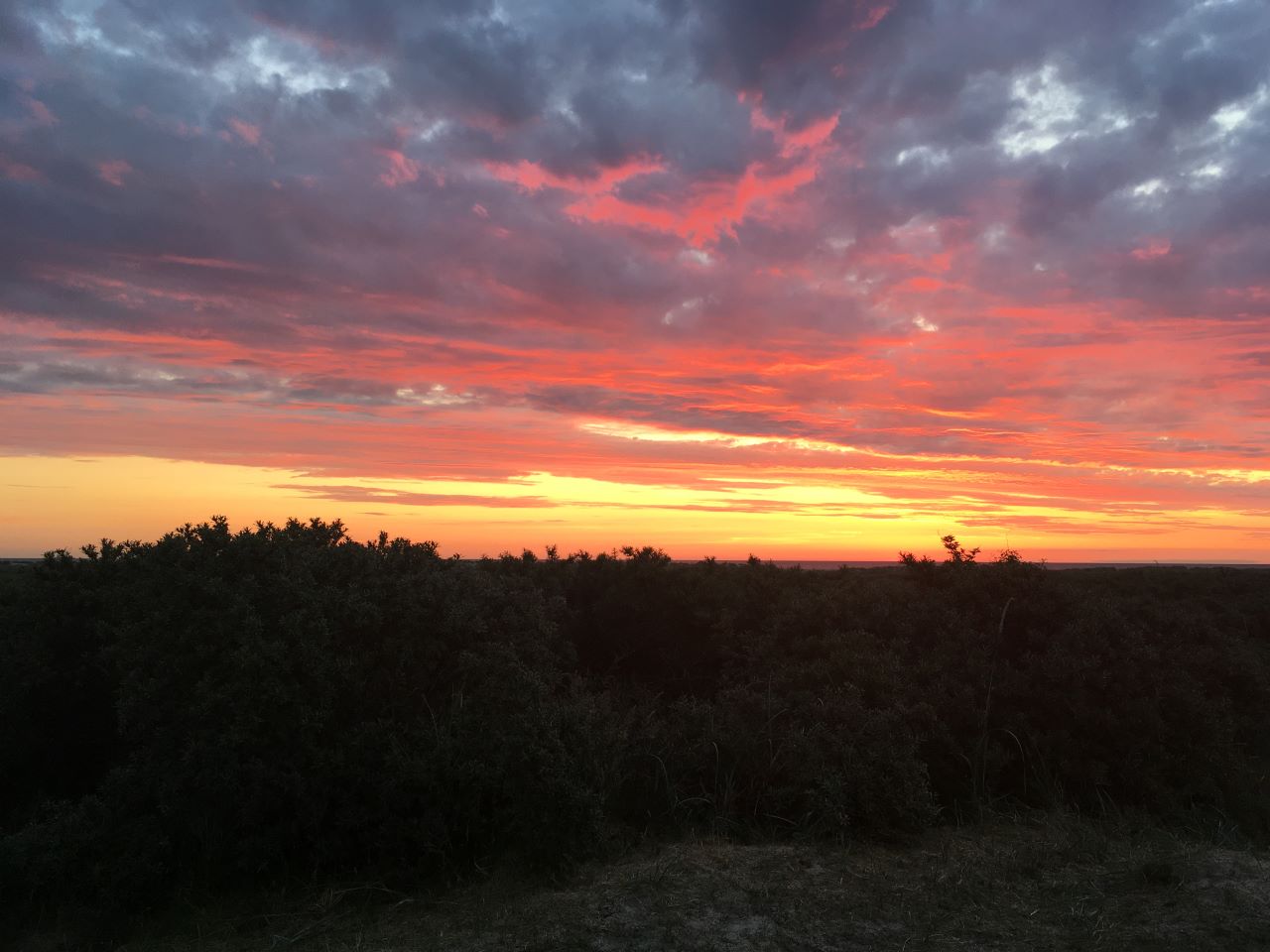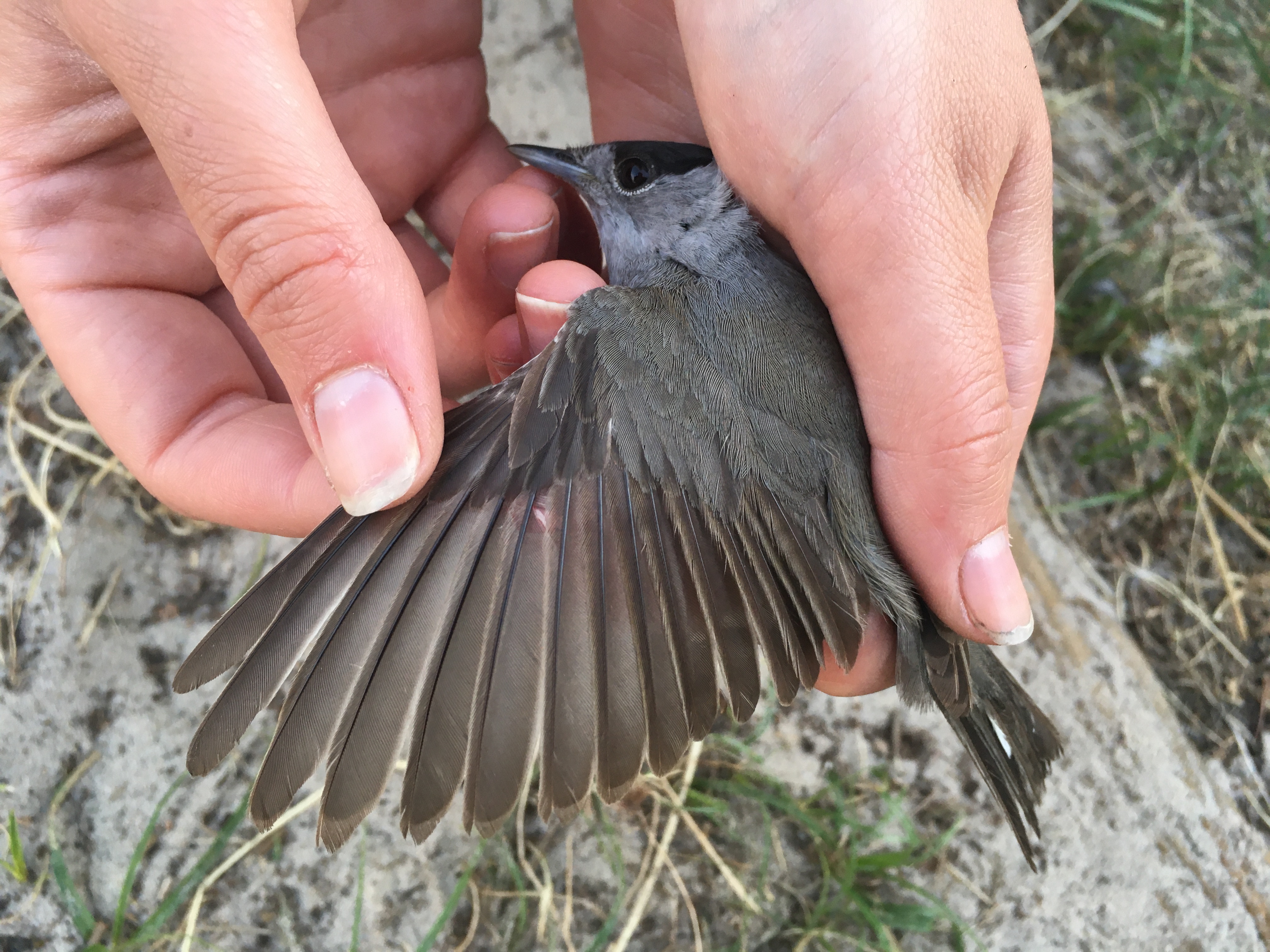Her på Skagen Fuglestations blog bringes korte nyheder i dagbogsformat om hændelser på fuglestationen.
Se indlæg fra måned: jan. (1)feb. (9)mar. (30)apr. (28)maj (31)juni (29)juli (31)aug. (31)sept. (29)okt. (31)nov. (30)dec. (2)
A slow catching day
Today was a quiet ringing day at Kabeltromlen. The sky remained cloudy the whole morning, but luckily it did not rain and we were able to keep the nets open. It was a slow day and we caught few birds. And all the Backcaps (Munk) were apparently gone ! We instead caught several Garden Warblers (Havesanger).
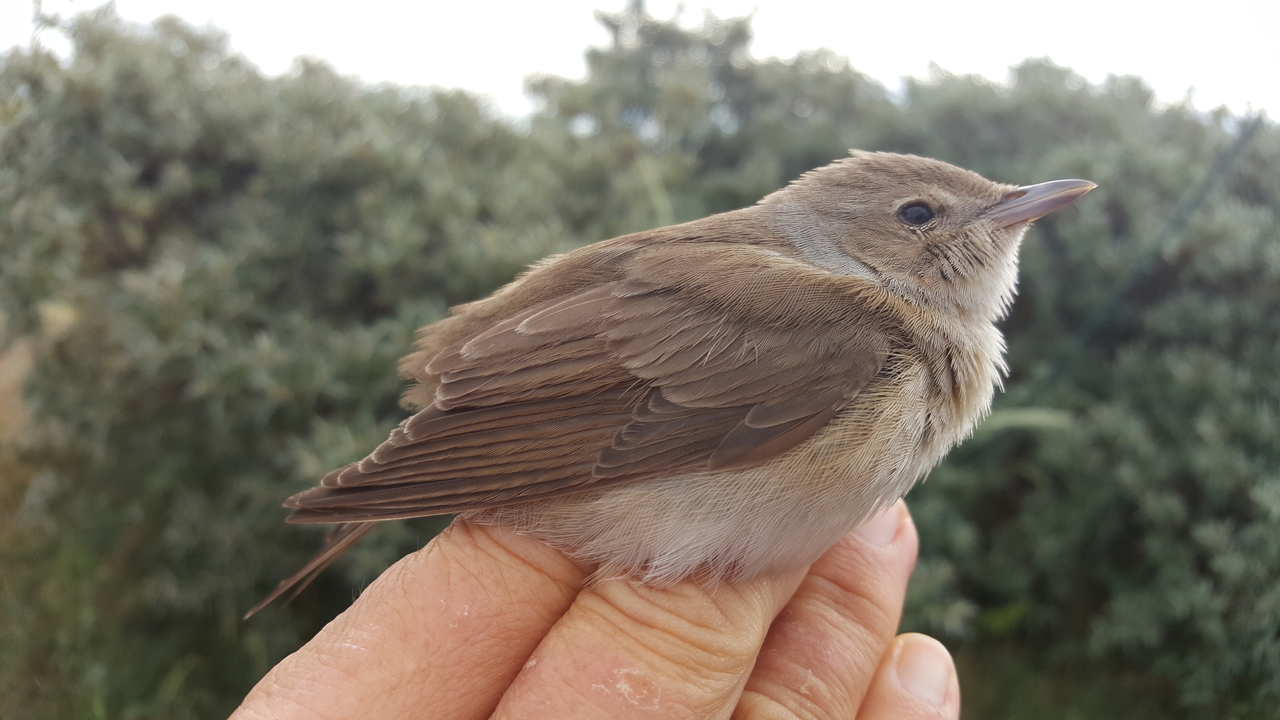
Garden Warbler (Havesanger)
One highlight of the morning was a very bright red male Bullfinch (Dompap Lille). Contrary to other pigments, red pigments are not directly produced by the birds. Instead, red birds rely on carotenoids - molecules found in the food they eat – to acquire a red coloration. Food such as leaves, seeds, berries and fruits are rich in carotenoids. However, carotenoids are a yellow pigment, and birds therefore need to use enzymes to convert them into red pigments. Brightness and extent of the red pattern is therefore affected by diet in red birds. A study1 from 2001 have compared coloration of wild and captive bullfinches and found that this bird has a unique way of producing red pigments, different from other close related species, which is quite interesting !
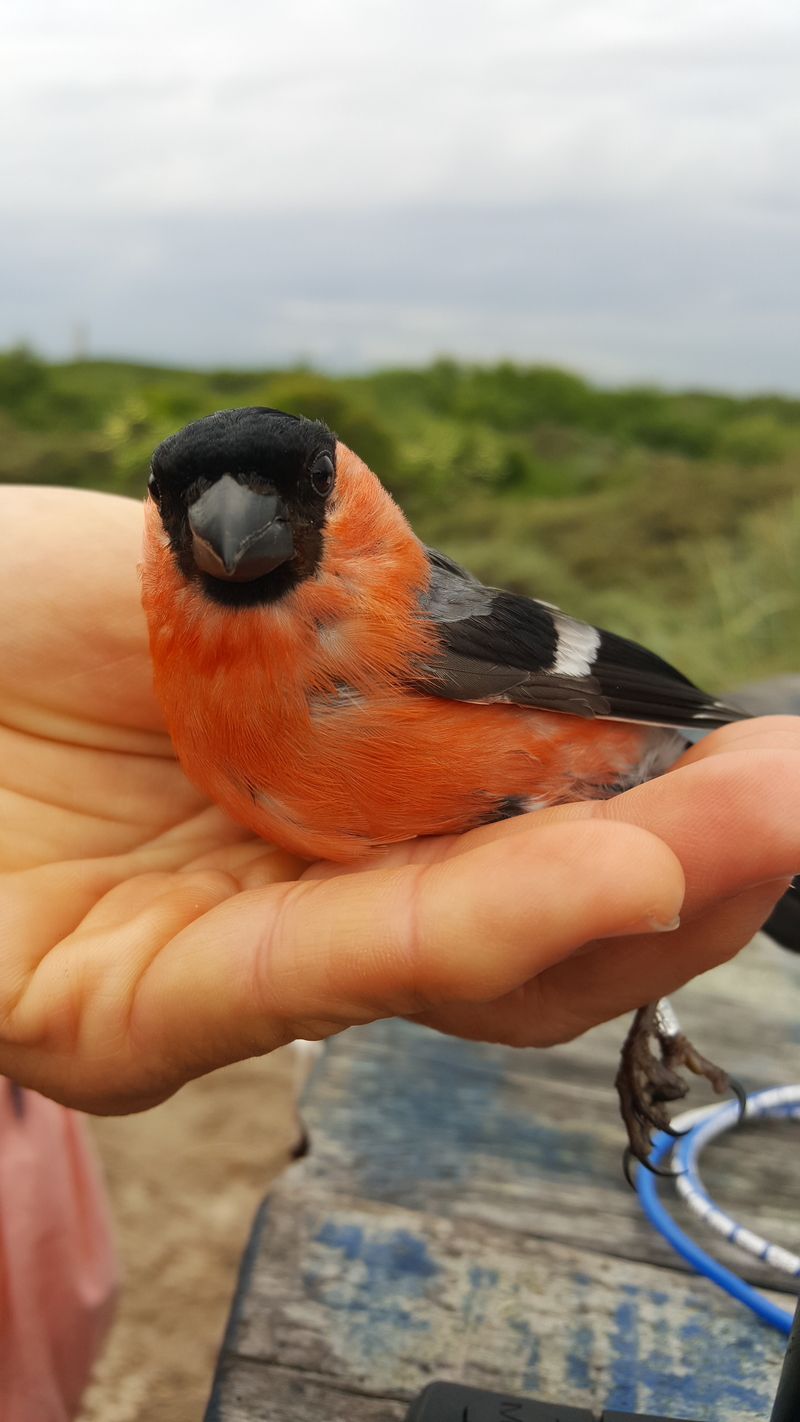
Bullfinch (Dompap Lille)
1 Stradi R, Pini E, Celentano G. Carotenoids in bird plumage: the complement of red pigments in the plumage of wild and captive bullfinch (Pyrrhula pyrrhula). Comp Biochem Physiol B Biochem Mol Biol. 2001;128(3):529-535. doi:10.1016/s1096-4959(00)00353-5
Ringmærkning (Kabeltromlen):
Rødstjert – Common Redstart – 1
Rørsanger – Reed Warbler – 2
Gærdesanger – Lesser Whitehtroat – 1
Lille Gråsisken – Lesser Redpoll – 2
Kærsanger – Marsh Warbler – 1
Løvsanger – Willow warbler – 2
Munk – Blackcap – 4
Havesanger – Garden Warbler – 5
Tornsanger – Common Whitethroat – 2
Dompap lille – Bullfinch – 1
Total: 21
People : Martina Hillbrand and Amandine Doré
Klik her for at se dagens observationer indtastet i Dofbasen af observatører i området
Klik her for at se opsummeret observationer af rovfugle i Skagen
Where did all the blackcaps come from?
This morning we went ringing without big expectations because the weather, although nice, did not promise a lot of birds with north winds and scattered rain clouds. It was good for a beautiful sunrise, though. The payment for getting up at 2.30 in the morning…
We are only two people now so not having too many birds is fine. We got a big surprise, however, when we started checking the nets and they were full of blackcaps (munk) in several net checks. Of course, we know that blackcaps are breeding around our nets and we can hear them singing and we also expect the young birds to fledge soon so there will be more. But today we ringed 30 (!) adult blackcaps almost all of which had a brood patch, meaning that they are actively breeding here or in the near surroundings. Also, very few of them were recaptures and seeing that we already had quite a few blackcaps yesterday we simply don’t know how they suddenly all ended up in our nets. The best guess is that the Corona restrictions for blackcaps have been lifted and they are finally allowed to have parties again.
The nice thing about catching a lot of birds of the same species is that you get really good in aging them and you can see even small differences in wear. You can look for the moult limit in the alula and the rather heavy wear of the flight feathers in this second year male:
Also getting a lot of data from birds of one species helps to do population studies and the like. So we definitely don’t complain about having lots of blackcaps. After all, they are very nice birds with a very beautiful song!
Next to lots of blackcaps we also caught a very pretty adult male redpoll (lille gråsisken).
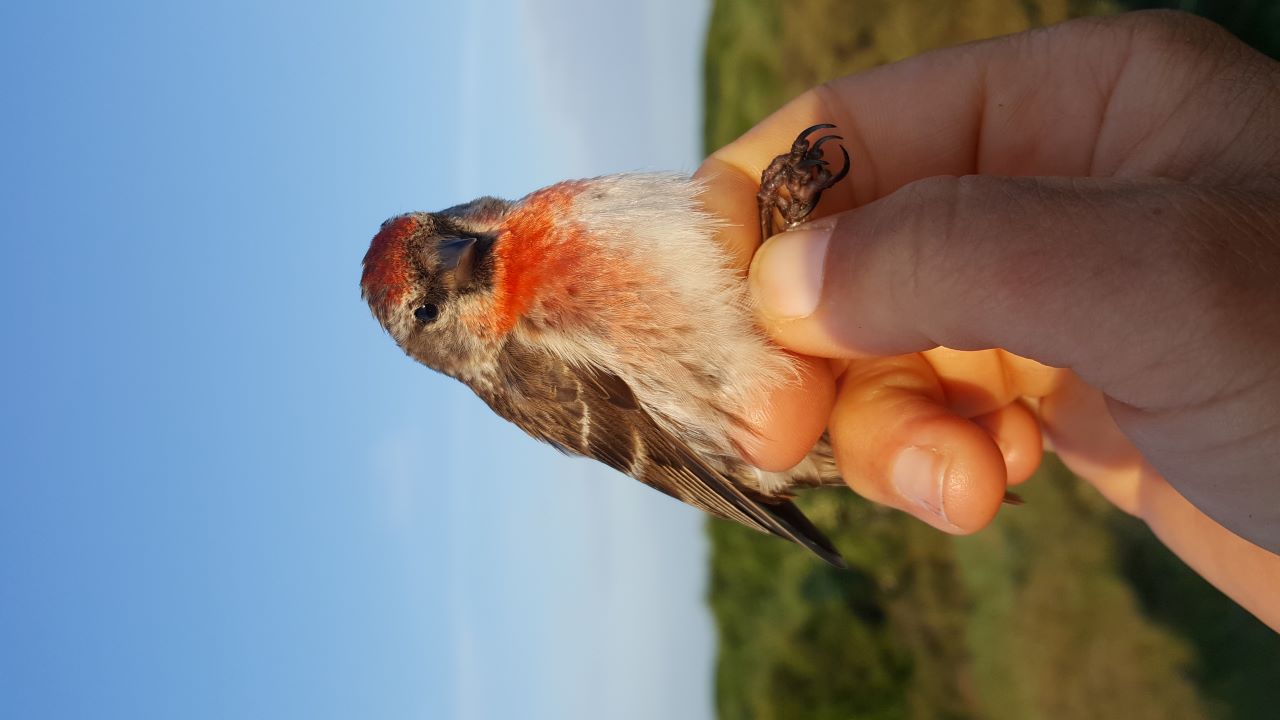
A nice surprise was a rosefinch (karmindompap). A male had been singing close to the ringing site many days but not continuously so we had no idea that it actually had a territory there but today we caught a female with an active brood patch. This is nice because in the last few years this bird was not known to breed around Skagen.
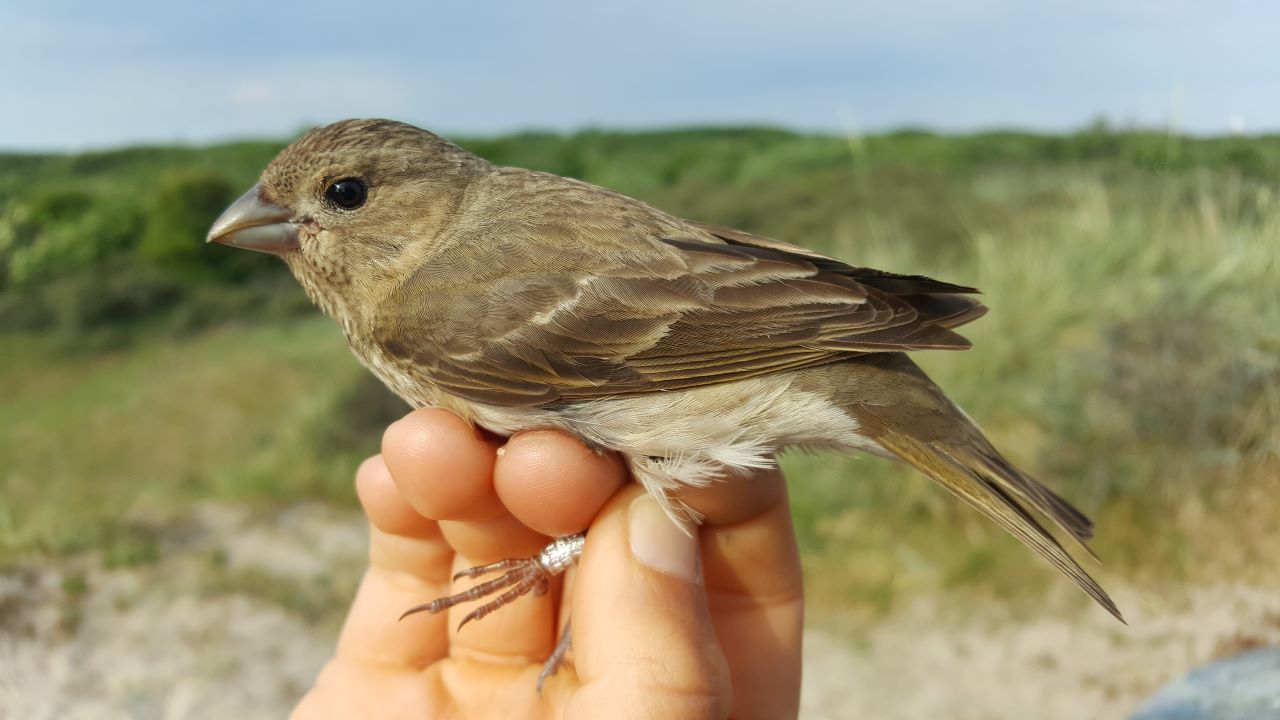
In the afternoon we went to the cormorant lake to monitor the breeding success there. Many chicks are by now so big you can also easily see them with binoculars. However, their feathers are still very thin and cannot get wet, so the parents still have to provide food and also protection from both sun and rain for the little ones. But it is good to see that they are growing fast and it looks like almost all nests have chicks by now.
Ringmærkning (Kabeltromlen):
Gransanger – Chiffchaff - 1
Havesanger – Garden Warbler - 4
Munk – Blackcap – 30
Topmejse – Crested Tit – 9
Rørsanger – Reed Warbler – 1
Gærdesanger – Lesser Whitethroat – 1
Lille Gråsisken – Redpoll – 2
Gærdesmutte – Wren – 1
Karmindompap – Rosefinch – 1
Total: 50
People : Martina Hillbrand and Amandine Doré
Klik her for at se dagens observationer indtastet i Dofbasen af observatører i området
Klik her for at se opsummeret observationer af rovfugle i Skagen
Exciting birds in the nets and in the sky !
Today, we went back ringing at Kabeltromlen, trying out our new nets disposition in the reeds. The weather starts to be very hot, and mosquitoes more and more numerous !
It was a really good day for catching, and we ringed almost 40 birds, of which a large part were female Blackcaps (Munk).
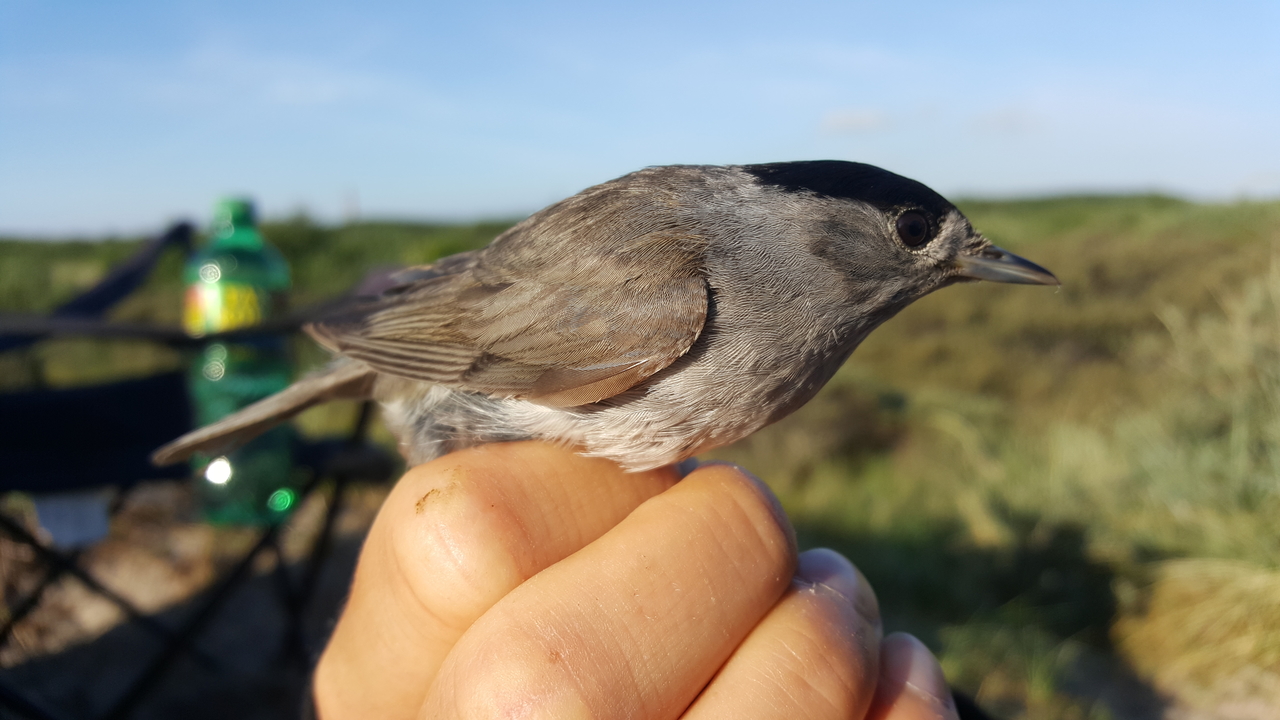
In the first round we also caught a female Grey Wagtail (Bjergvipstjert).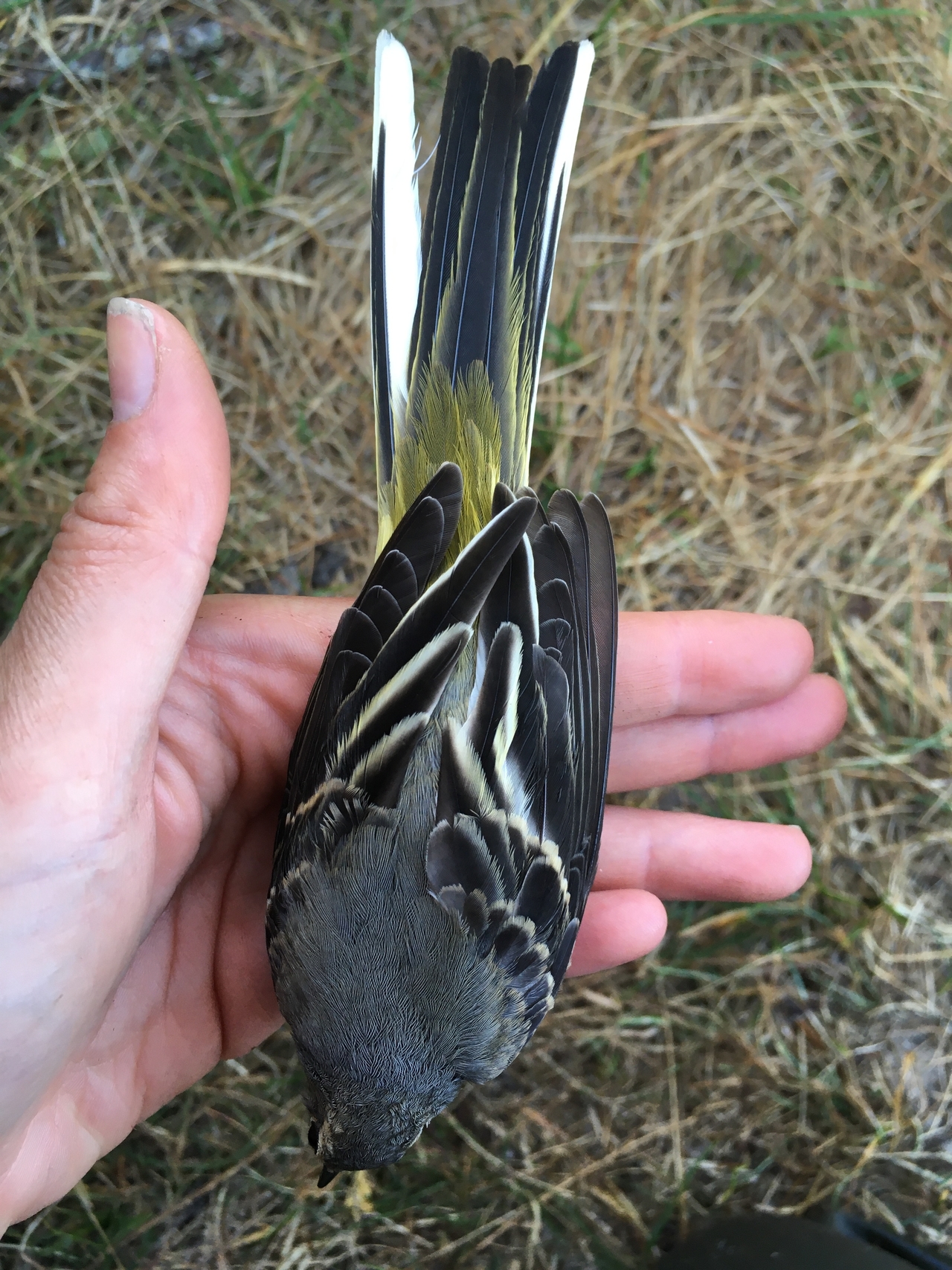
Later on, we were surprised to catch two newly hatched and very pretty Bearded tits in the reeds !
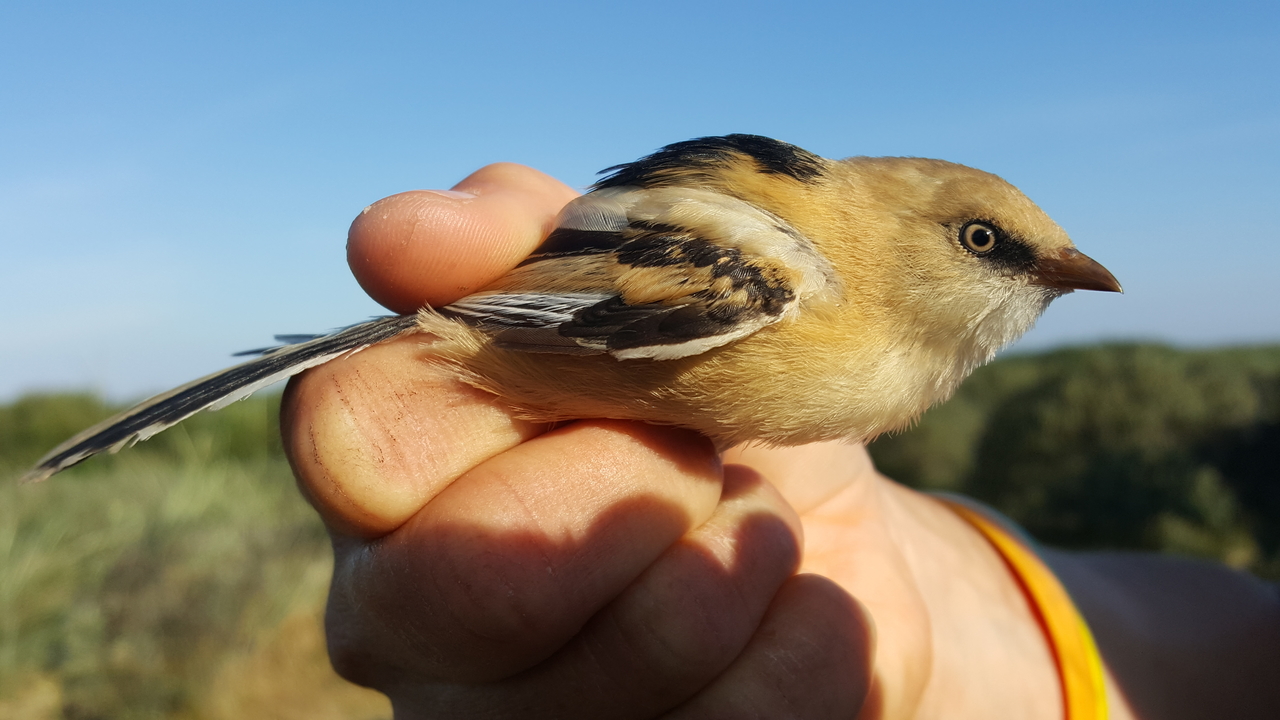
Since several days, we have also been catching Crested tit’s (Topmejse ) hatchlings in the nets, and today we got 3 of them ! There are several characteristics that can be used to differentiate newly-hatched Crested tits from older birds: usually the crest is not fully developed, the eye is brown while in the adults it is reddish-brown, and some parts of the body still don’t have feathers.
We are expecting to catch more and more hatchlings, as the season progresses. We have so far caught young Crested tits, Bearded Tits, and Blackbirds, and more should come soon !
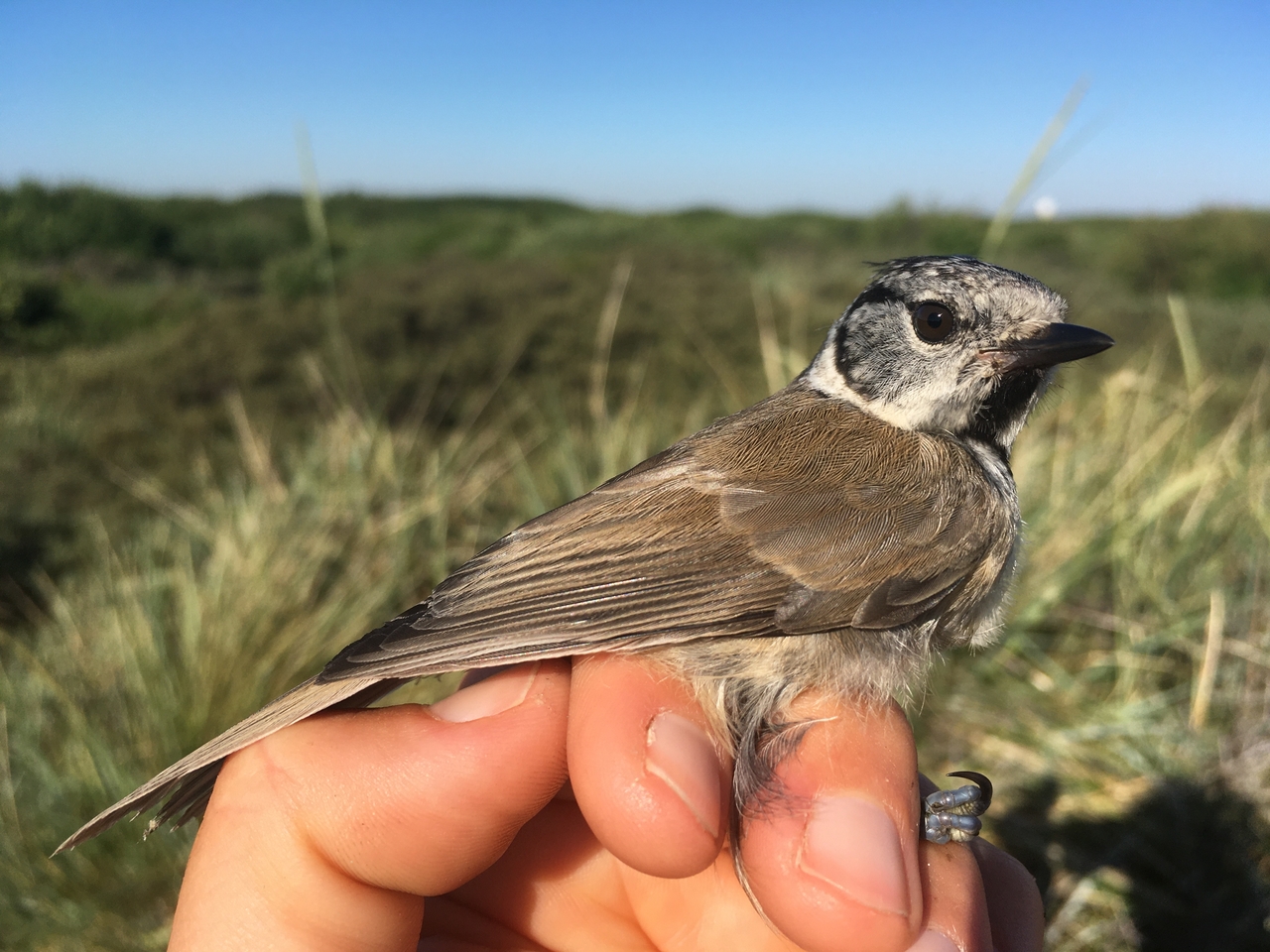
On our last round, we caught one very beautiful Hawfinch male (Kernebider). Hawfinches are unmistakable thanks to their very massive and wide bill that they use to feed on large hard seeds (such as cherry seeds).
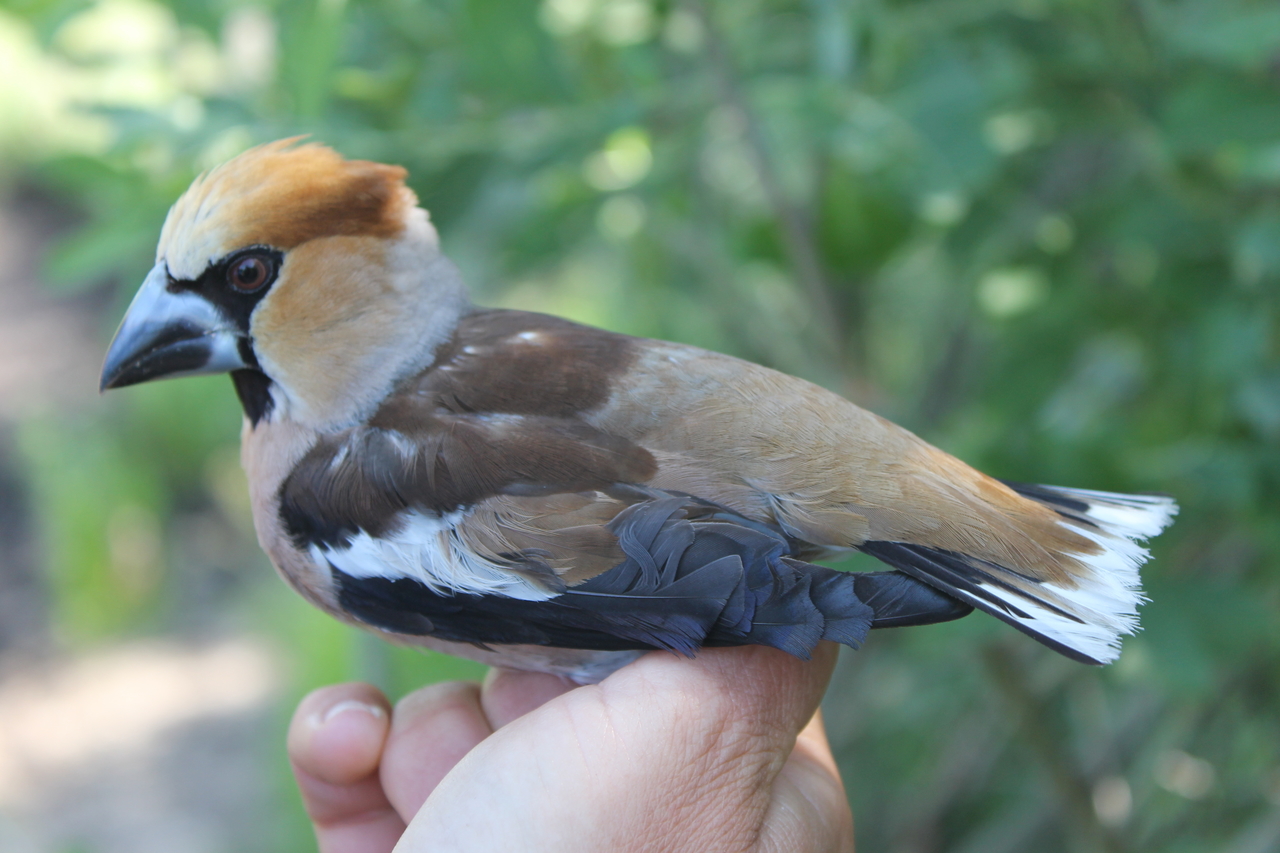
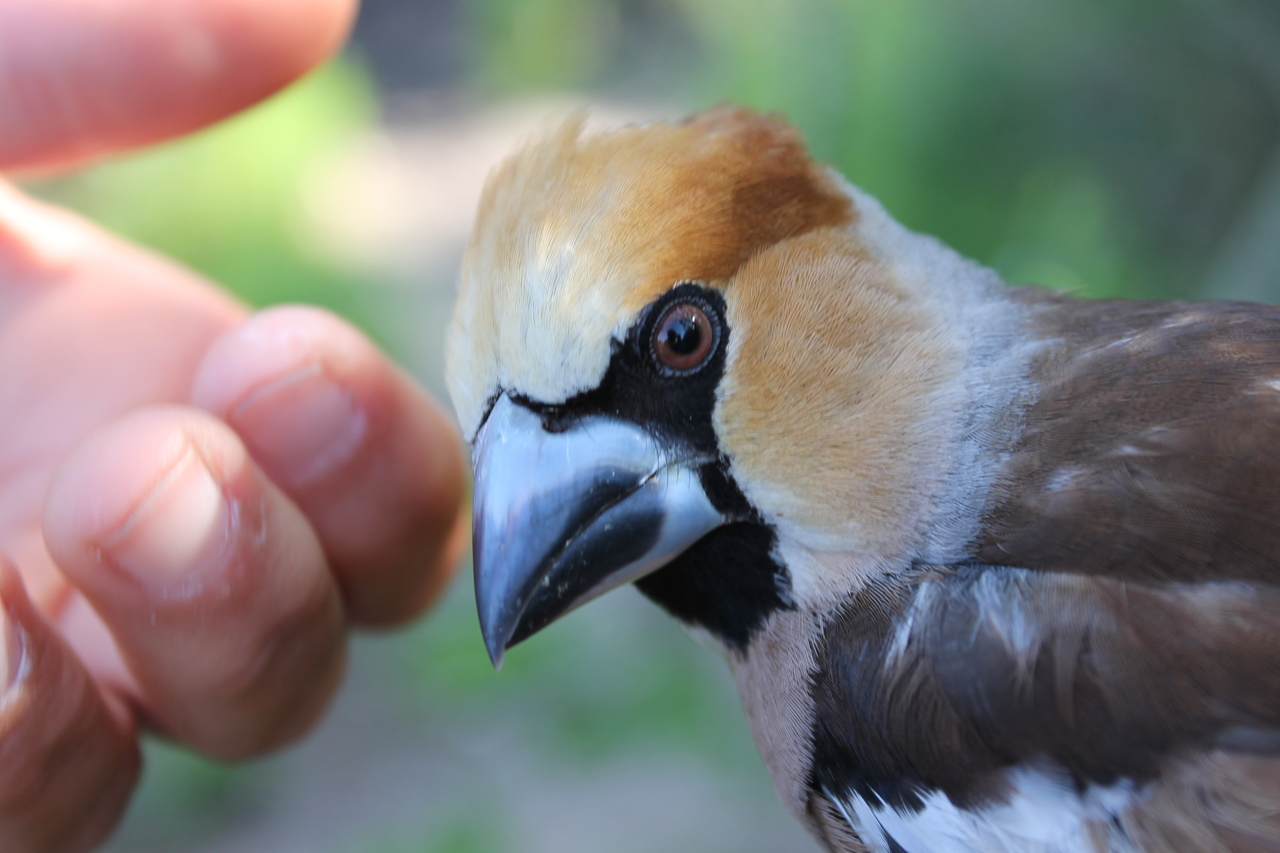
We also caught two Lesser redpolls (Lille Gråsisken).
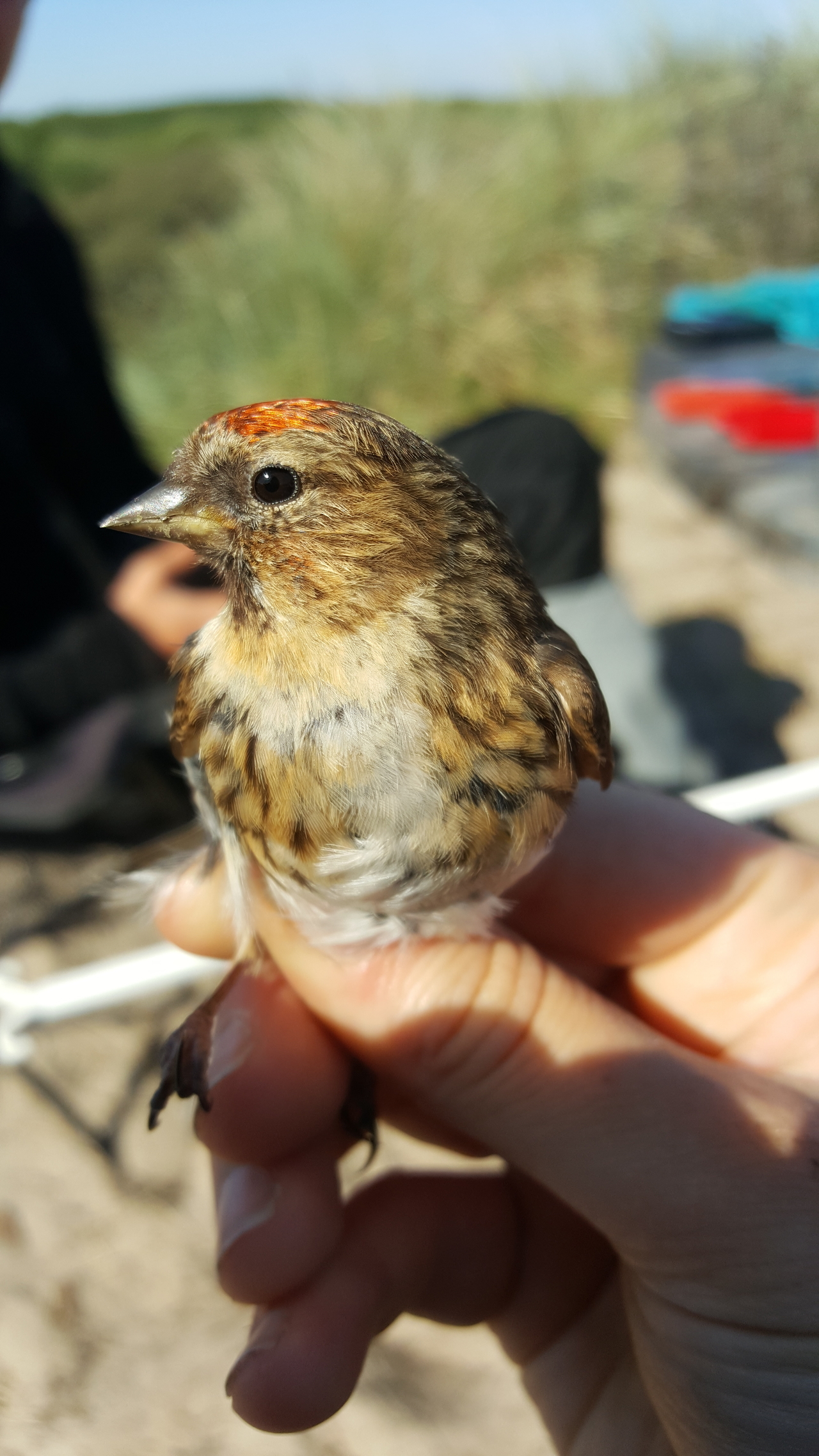
And last but not least, we saw again a Lesser-spotted Eagle (Lille skrigeørn) alongside Common and Honey Buzzards while ringing !
In the afternoon, we followed our normal routine, completing our daily tasks. Frederik left and will come back on Monday.
Ringmærkning (Kabeltromlen):
Gransanger – Chiffchaff - 1
Havesanger – Garden Warbler - 4
Munk – Blackcap – 16
Topmejse – Crested Tit – 3
Kærsanger – Marsh Warbler – 1
Rørsanger – Reed Warbler – 1
Sangdrossel – Song Thrush – 1
Gærdesanger – Lesser Whitehtroat – 2
Solsort – Blackbird – 1
Skægmejse – Bearded Tit – 2
Bjergvipstjert – Grey Wagtail – 1
Kernebider – Hawfinch – 1
Lille Gråsisken – Redpoll – 3
Total: 37
People : Martina Hillbrand, Frederik R. Johansen and Amandine Doré
Klik her for at se dagens observationer indtastet i Dofbasen af observatører i området
Klik her for at se opsummeret observationer af rovfugle i Skagen
Amphibians and Eagles
Today was another day for the CES ringing at Jennes Sø. This focusses on breeding birds so we catch fewer new birds and more recaptures. It gives us a chance to follow some individual birds over a longer period of time. For example we had a blue tit (blåmejse), a pretty male, which has probably already finished breeding and has now started to moult its wing feathers. Males often start to moult earlier than females as females tend to have more work with the offspring (of course we do not want to draw any parallels here to the world of the humans).
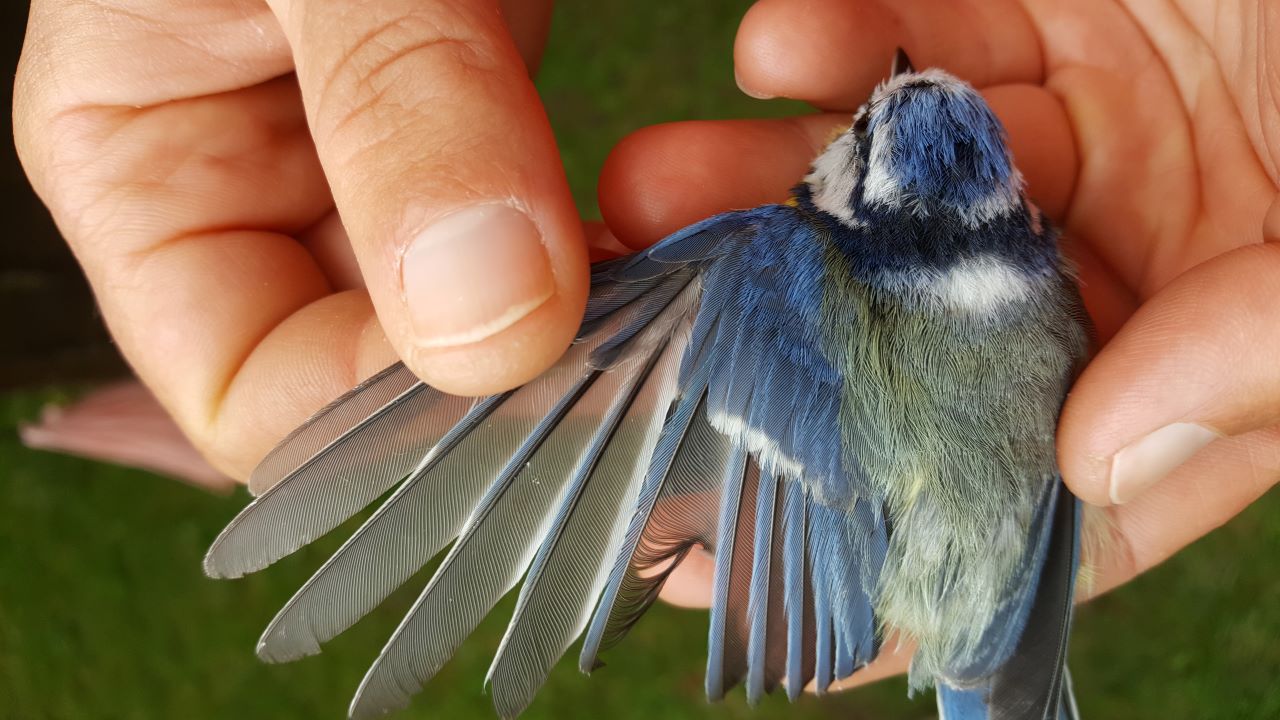
We only ringed 10 birds today but we also had 6 recaptures, and although we had few birds at least we had some variety. And it was not hot as in the morning it was raining a little bit.
We also caught this beautiful tree pipit which was nice since normally we hear them sing all the time but we rarely catch them.
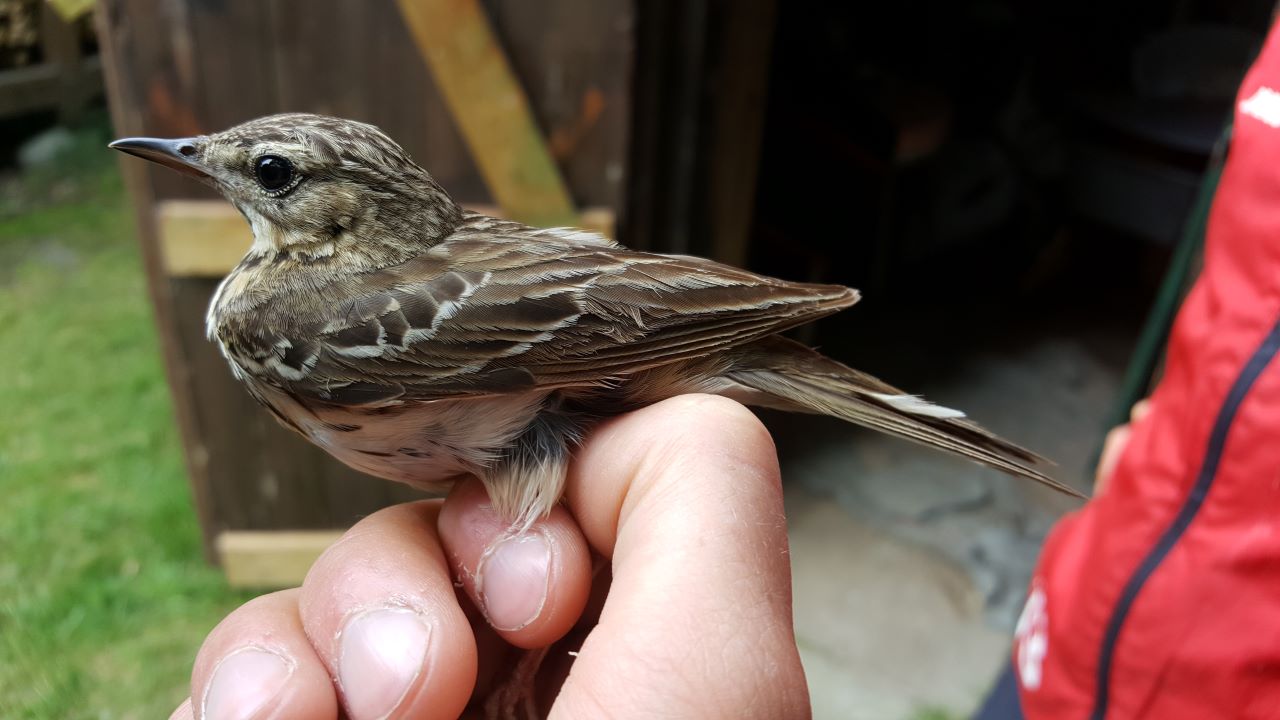
Also, since there were not that many birds, we got to study a few other animals too. The lake was full of tadpoles, some without legs and some already with legs. And on the grass dozens of tiny baby toads were hopping away from the water. A good chance to see the development of amphibians close up.
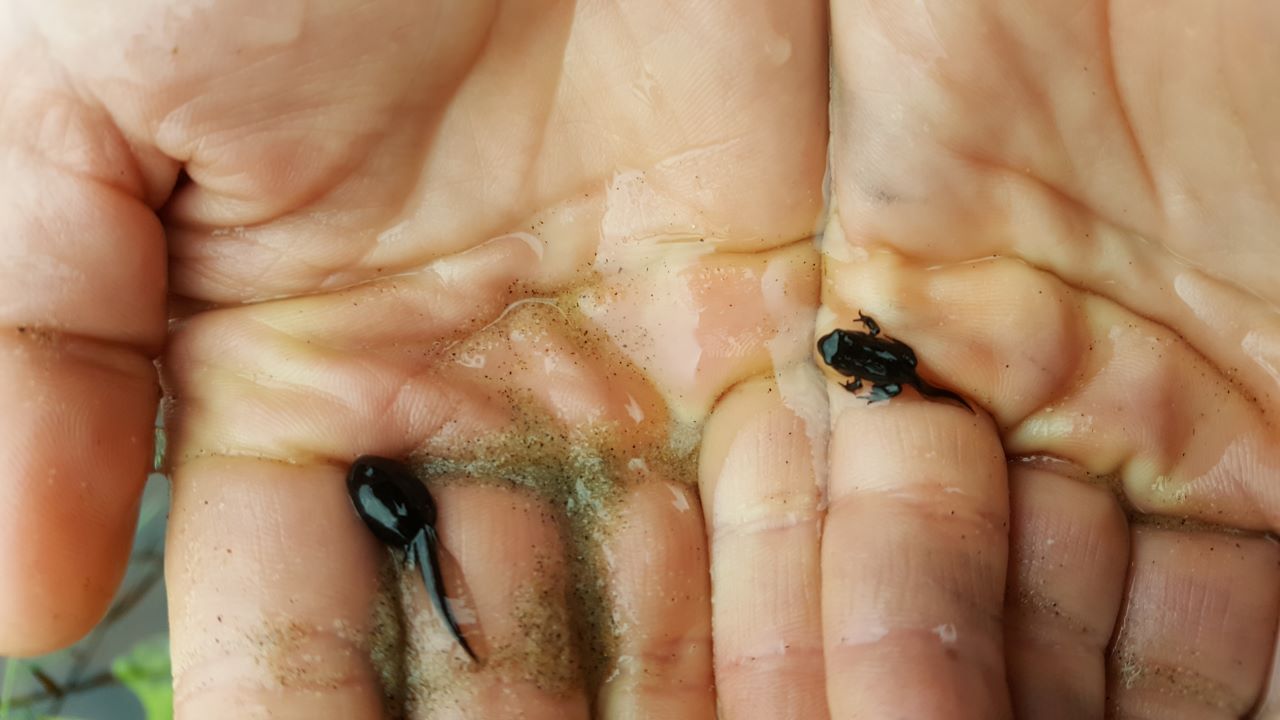
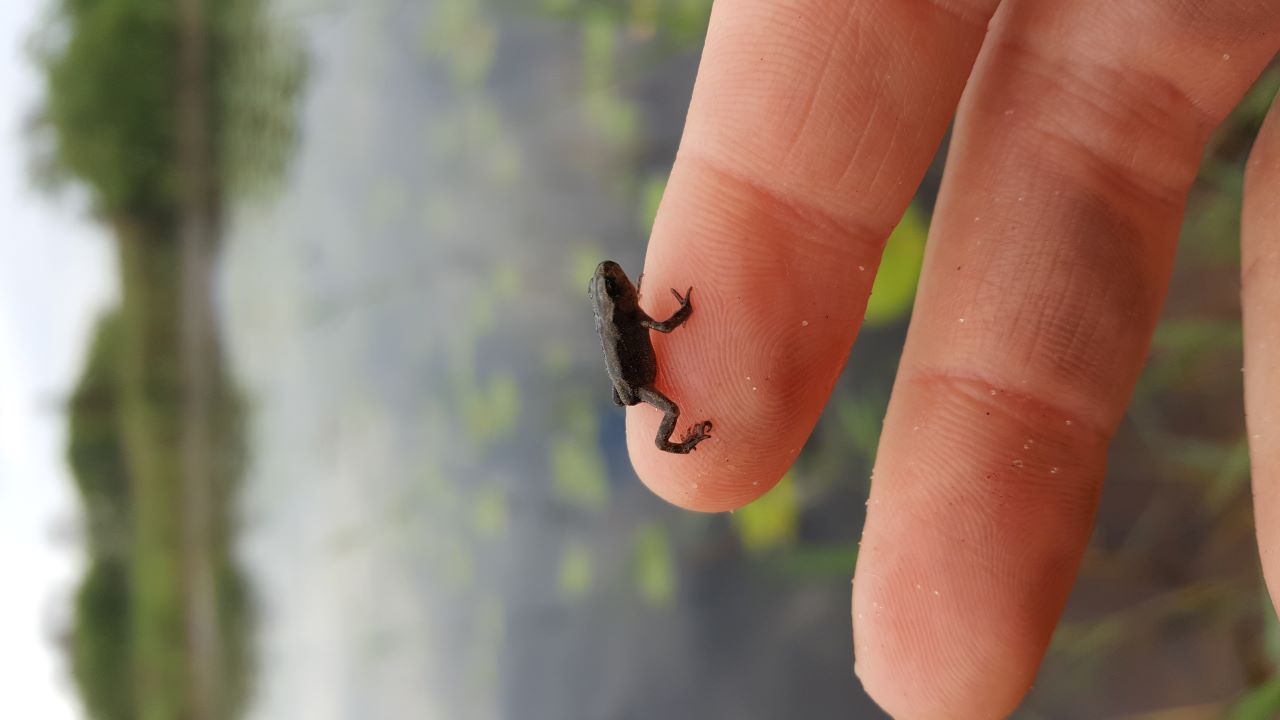
After the ringing we went home and while the girls slept Frederik went out to look for raptors and he was lucky enough to finally see the steppe eagle (steppeørn) he had always missed when it was here. Apparently it is the same bird that was here several days two weeks ago and then left. It was seen in Aalborg yesterday but after a short visit to the rest of Denmark decided to come back here. We can totally relate to that since here is just the best part of Denmark!
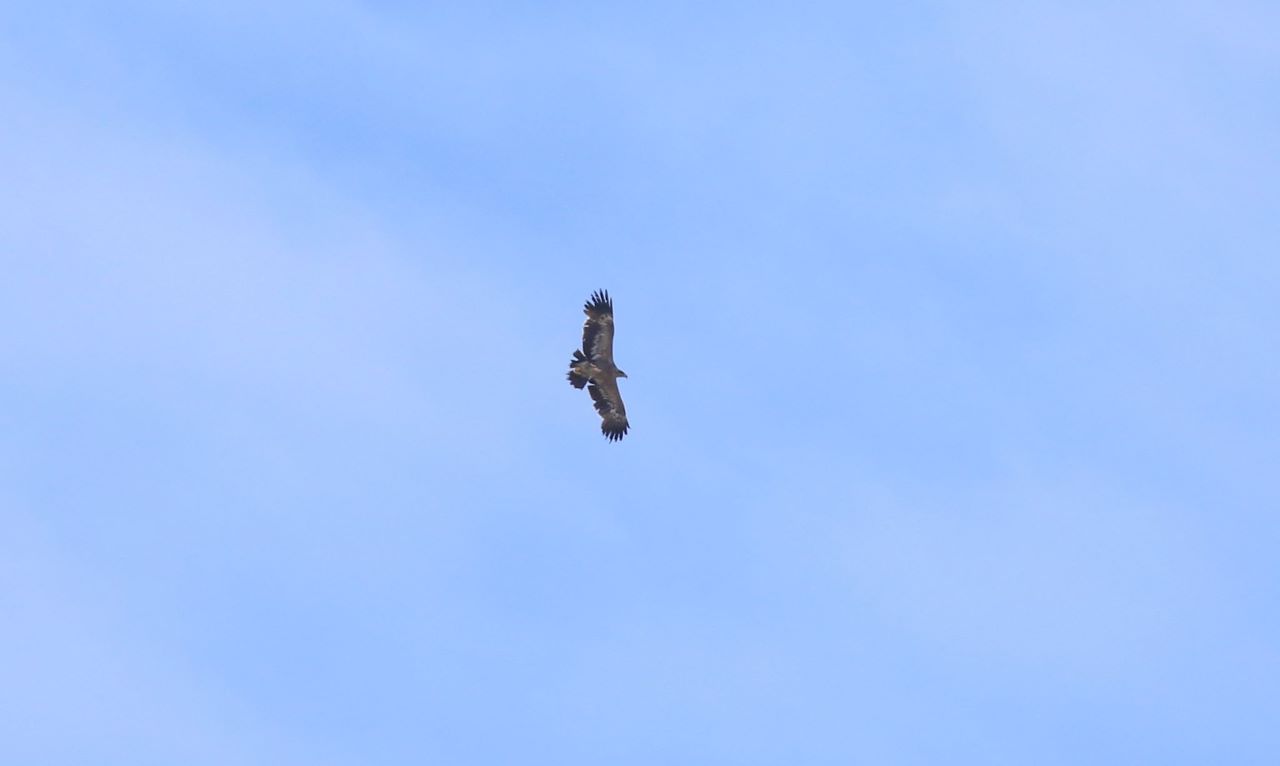
But not only did he see the steppe eagle but he was also lucky enough to see it right next to a lesser spotted eagle (lille skrigeørn) which is a very rare but wonderful opportunity to compare the two species.
In the afternoon first we had a visit from Martin, who works for Swarowski in Denmark and brought us a brand new pair of digital binoculars which we get to test over the next few weeks. We are really excited to see how they work and will report once we get a good impression!
After that we all went to Grenen in order to move a net to a different place and we also set up another net, so now we have a total of 23 nets out there. The new location is also more in the reeds so we might catch different species there. Tomorrow we will get to test it!
Ringing Jennes Sø:
Skovpiber – Tree Pipit – 1
Blåmejse – Blue Tit - 1
Gærdesmutte – Wren – 1
Gulbug – Icterine Warbler – 1
Solsort – Blackbird - 2
Munk – Blackcap – 2
Rødhals – Robin – 1
Gransanger – Chiffchaff -1
Total:10
People : Martina Hillbrand, Frederik R. Johansen and Amandine Doré
Klik her for at se dagens observationer indtastet i Dofbasen af observatører i området
Klik her for at se opsummeret observationer af rovfugle i Skagen
Newly hatched Crested tits (Topmejse ) in the net !
This morning, Martina and me went opening the nets, while Frederik enjoyed a little extra sleep and joined us for the first round. The weather conditions were very good - sunny weather, warm and not much wind - which is unfortunately also perfect for mosquitoes !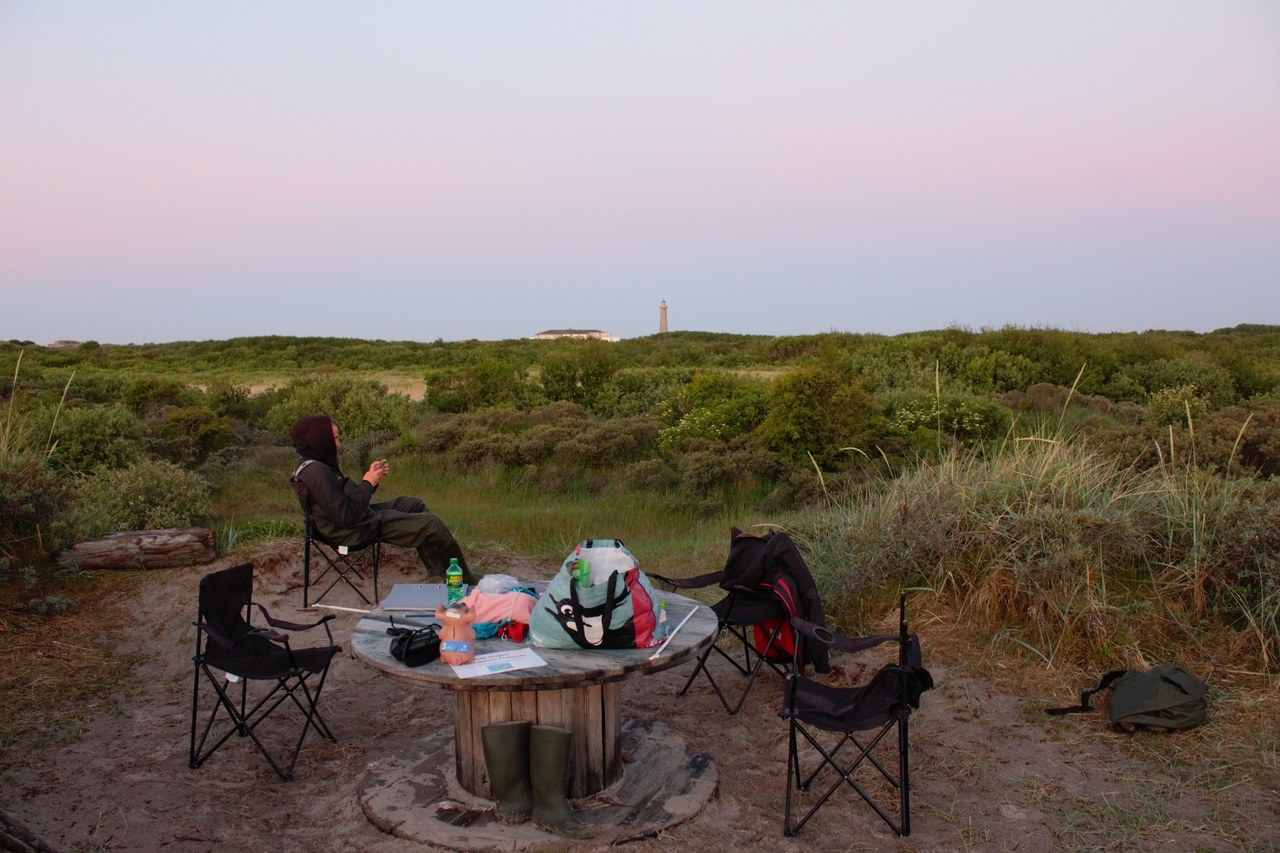
We caught more birds than we had these last few days. In our last rounds to the net, we caught 4 Crested tits (Topmejse), all of them likely born this year. This species is highly social and form small flocks, therefore it is not unusual to caught several of them in the nets.
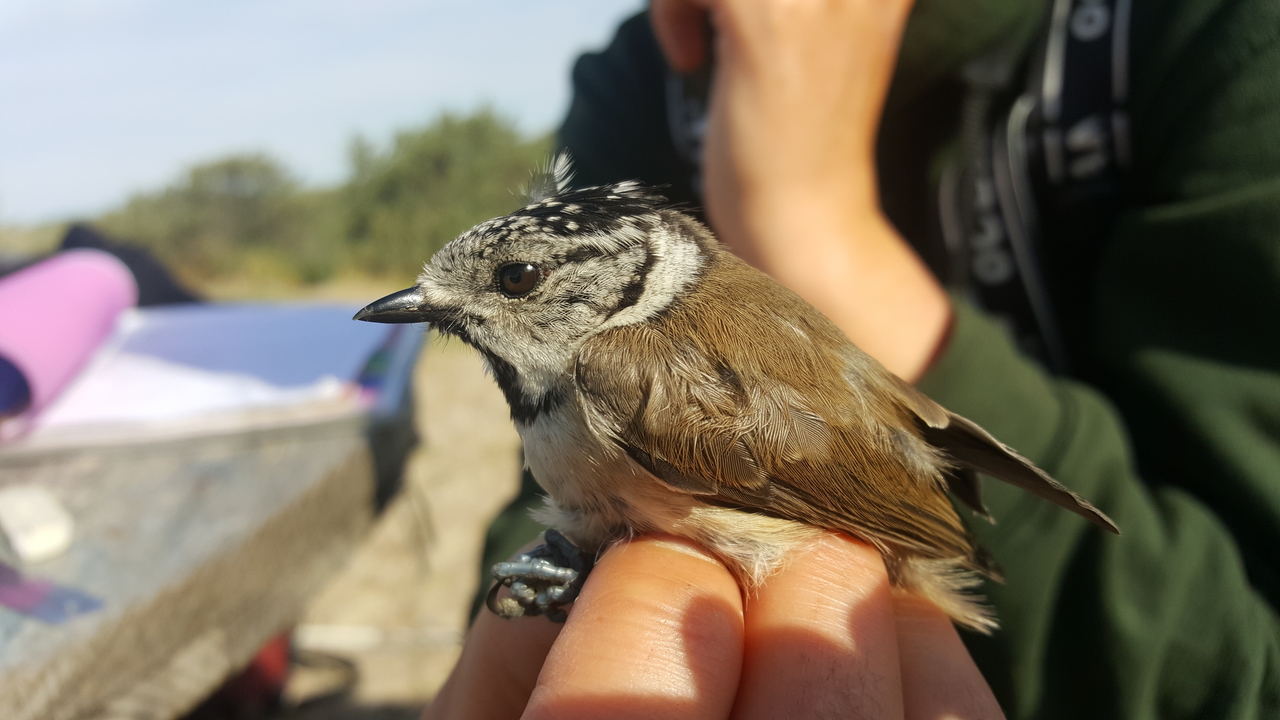
Ringmærkning (Kabeltromlen):
Gransanger – Chiffchaff - 1
Lille Dompap – Bullfinch – 1
Bogfinke – Chaffinch - 5
Havesanger – Garden Warbler - 1
Tornsanger – Common Whitethroat – 4
Munk – Blackcap – 13
Topmejse – Crested Tit – 3
Kærsanger – Marsh Warbler – 4
Rørsanger – Reed Warbler – 2
Sangdrossel – Song Thrush – 1
Gærdesmutte – Wren – 2
Gærdesanger – Lesser Whitehtroat – 2
Total: 39
People : Martina Hillbrandt, Frederik R. Johansen and Amandine Doré
Klik her for at se dagens observationer indtastet i Dofbasen af observatører i området
Rosenstær og Spurvehøg
I dag startede Amandine og jeg med at tage ud og åbne net. Senere kom Lars og hjalp til med ringmærkningen. Det gik godt i dag. Vi var nemlig så heldige at få lov til at ringmærke en Spurvehøg!

Klokken 0640 kom der en FLOOOOOT Rosenstær på trækforsøg. Det var dagens højdepunkt, for den er bare så lææækker!!

Amandine blev herhjemme og jeg tog ud at se på sommerfugle. Så en masse fede og smukke sommerfugle!
Her til aften kom Martina tilbage, og vi ser meget frem til de næste dage sammen med hende igen!
Ringmærkning (Kabeltromlen):
Spurvehøg - 1
Kærsanger - 2
Rørsanger - 2
Gulbug - 1
Gærdesanger - 2
Munk - 7
Lille Gråsisken - 3
Rørspurv - 1
Sum: 19
Klik her for at se dagens observationer indtastet i Dofbasen af observatører i området
Klik her for at se opsummeret observationer af rovfugle i Skagen
Folk: Amandine Doré, Lars Bo Jacobson, Thomas W. Johansen og Frederik Johansen.
A day of office work
Today it’s only me and Frederik at the station. Because we were only 2 and because the weather was not very good, we did not go out ringing. We used the time we had to complete other tasks, such as cleaning, entering data and other office work. 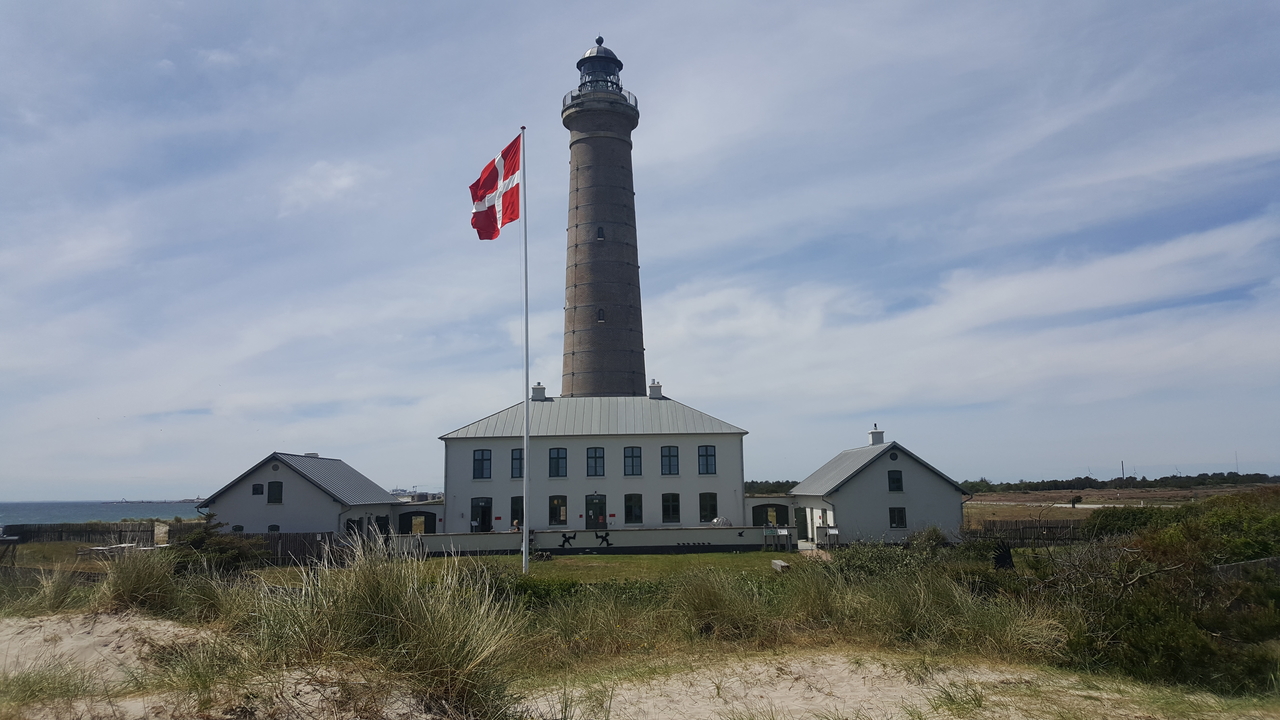
Frederik went bird watching during the afternoon and saw a female Greta Reed Warbler while I stayed at the station and worked on the computer. I also went to visit the lighthouse exhibition and then climbed up the lighthouse tower for the first time since I arrived. The views on Skagen peninsula from there are wonderful.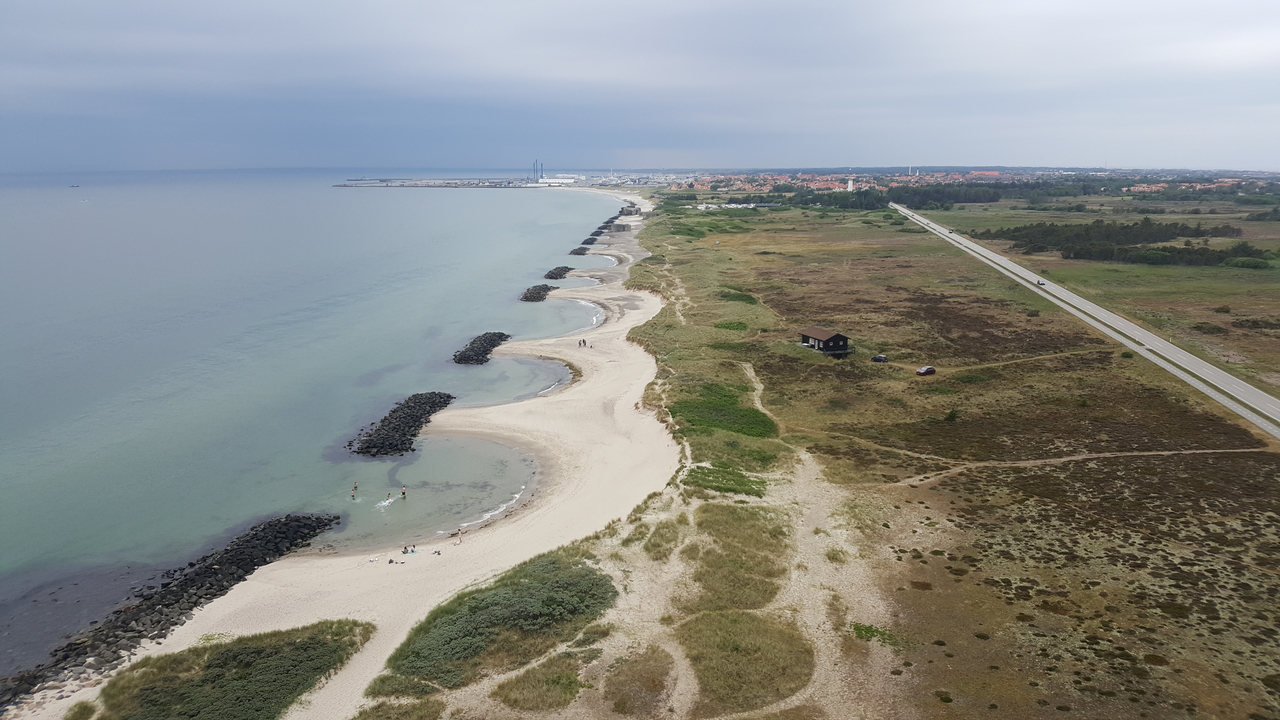
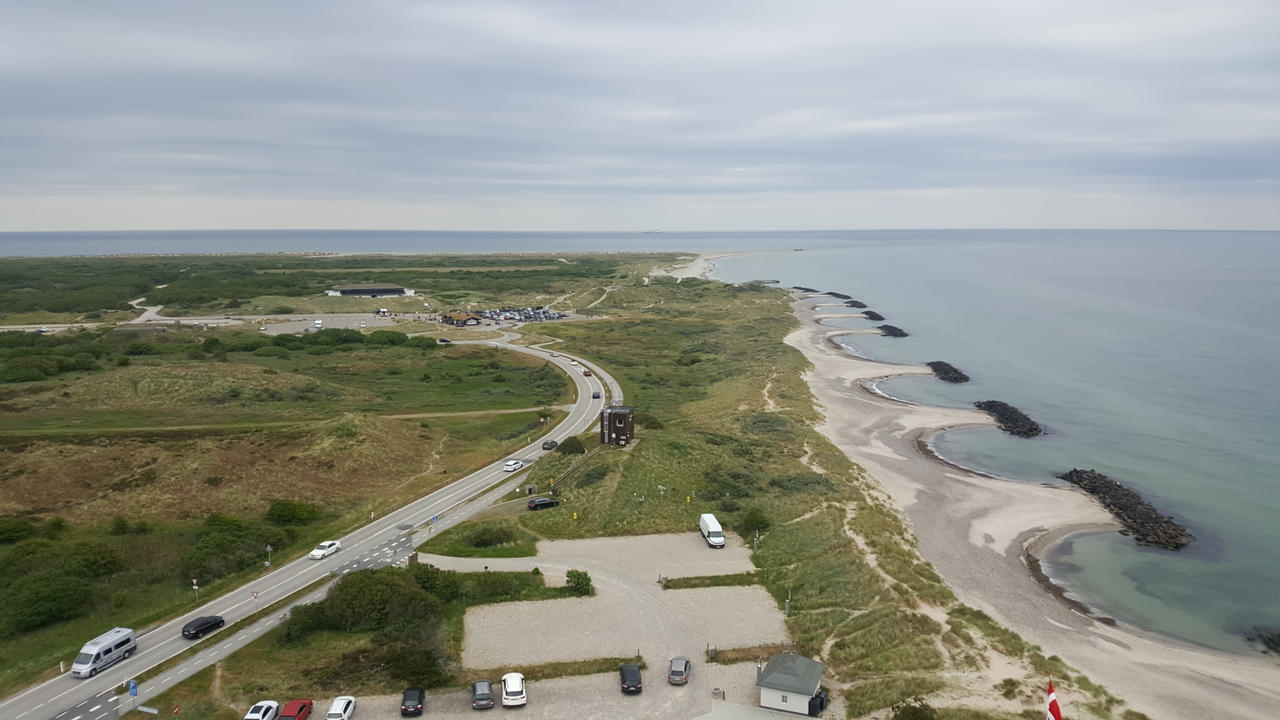
Frederik R. Johansen and Amandine Doré
Klik her for at se dagens observationer indtastet i Dofbasen af observatører i området
Klik her for at se opsummeret observationer af rovfugle i Skagen
A busy day of surveying and catching in Skagen AND aurevoir Skagen !
Today, Frederik, Fanny and I went out ringing at the Cable Drum. As migration period is reaching an end, the number of birds caught in the nets is slowing down. Moreover, today was very windy and we decided to close the nets earlier. Only 5 birds were caught.
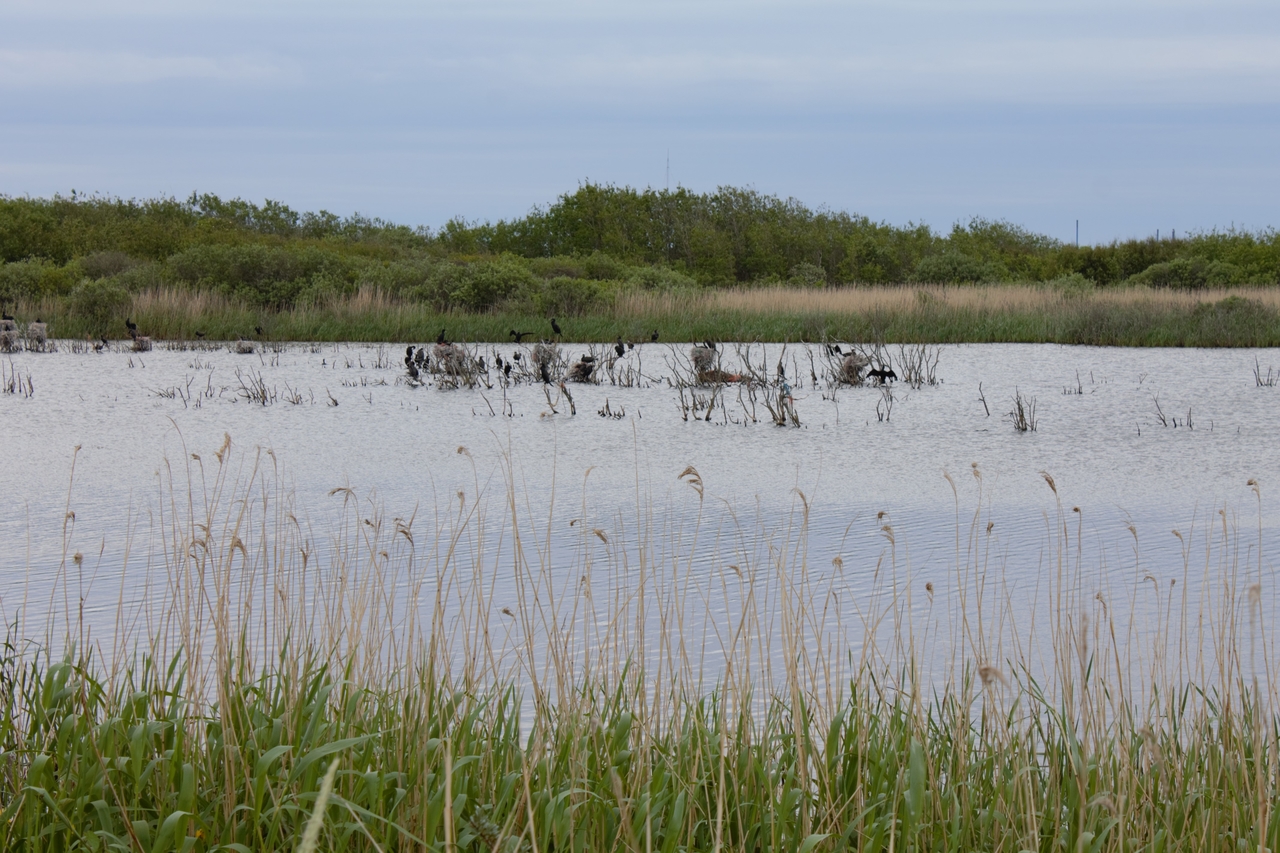
Later in the morning, Fanny and I went out to the Cormorants’ Colonies, to do a survey of the nests and chicks. There are about 30 active nests in this colony, and today we saw that a large part of the nests had chicks, usually between 2 and 3. We could see the parents regurgitating food to their nestlings, and some of them were already big. We also saw several females incubating but couldn’t know for sure if there were chicks or still eggs.
In the afternoon, Fanny and I decided to try to catch adult Common Ringed Plovers, after ringing the chicks yesterday, while Frederik decided to go and look for a Rock Thrush that had been seen these previous days. We tried to trap the adult plovers, but unfortunately this was not successful. We however, found a nest, which was very well camouflaged among the rocks ! Common Ringed Plover lay their eggs directly on the ground, in open and bare habitat, relying on camouflage to protect their nest, eggs and young chicks.
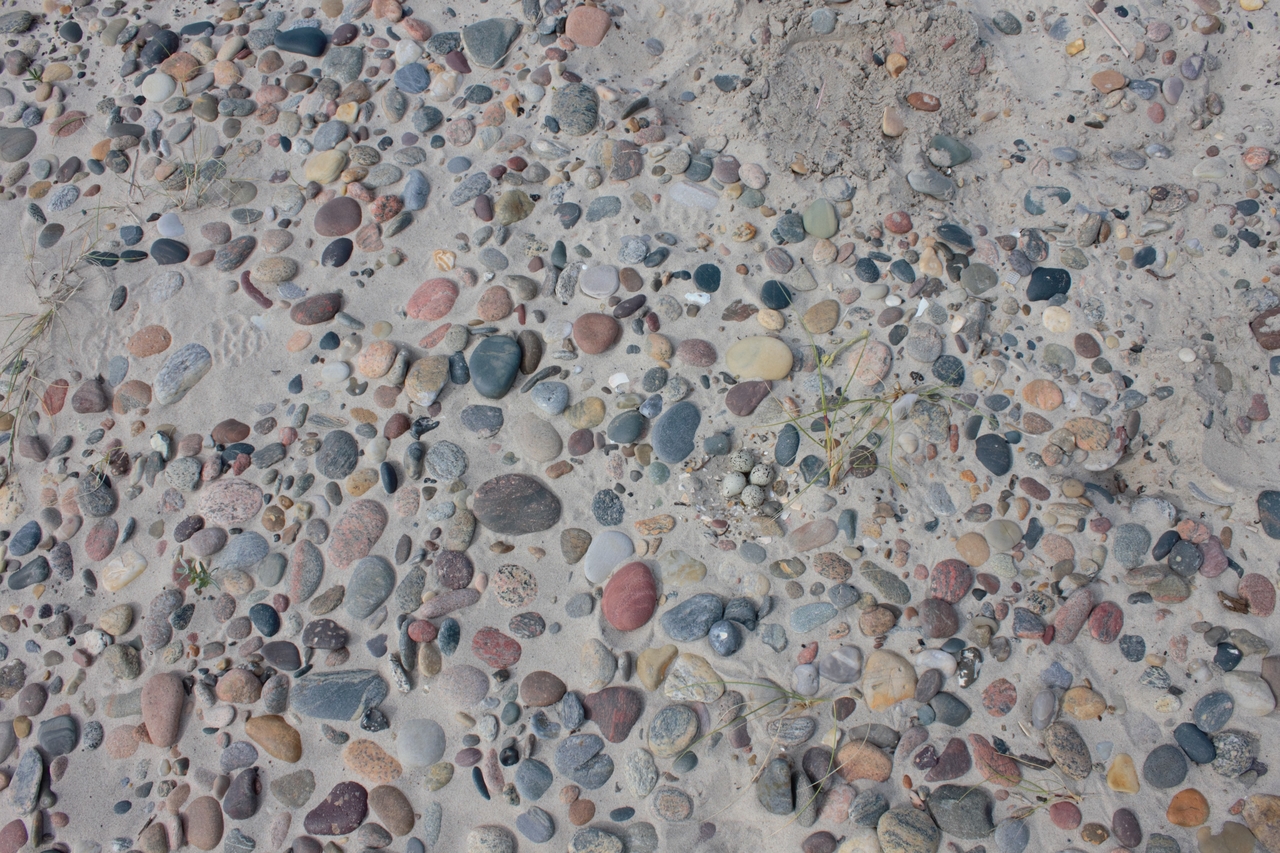
Can you find the nest ?
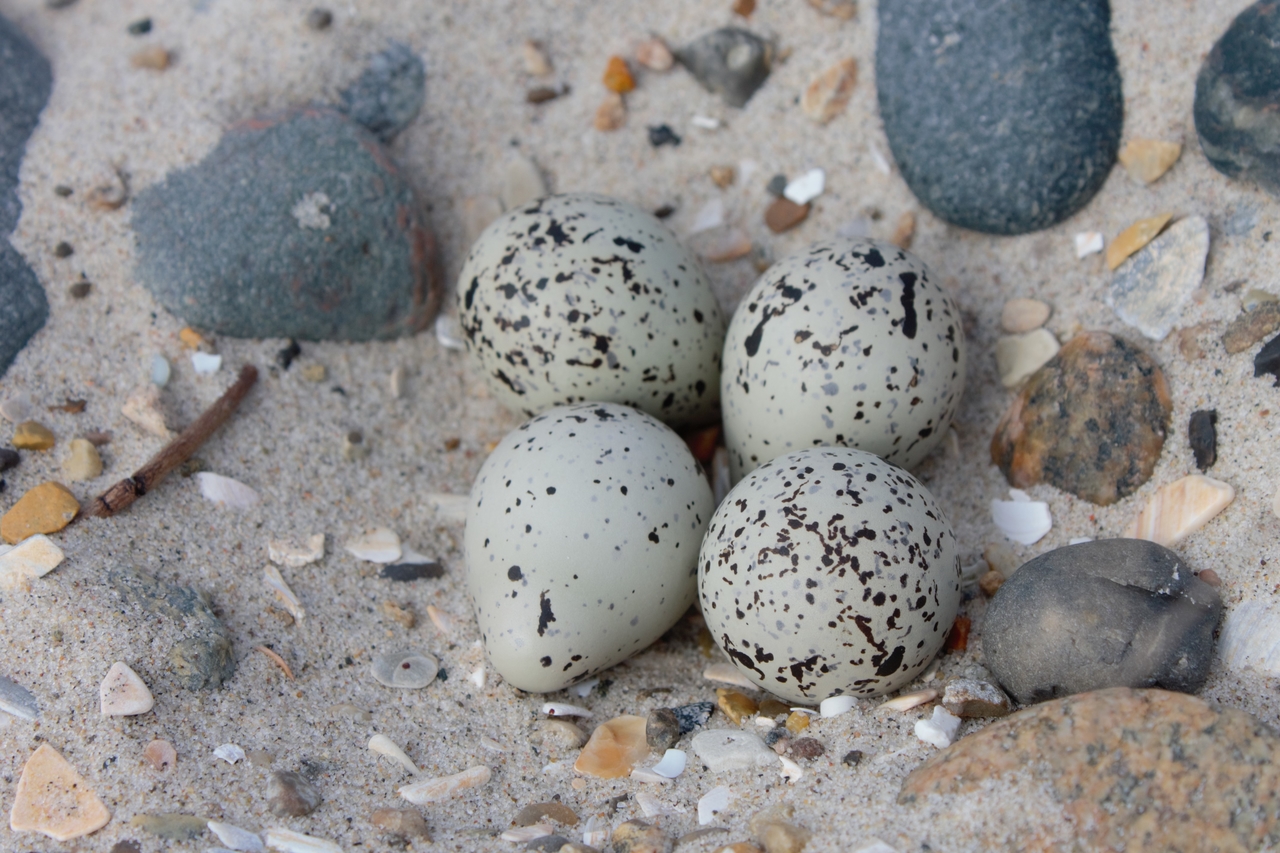
We ended up the day by a nice dinner in the Café Blink at the Lighthouse, which was celebrating its reopening today. The food was really good and we enjoyed this relaxing time after a very busy day.
Fanny :
It is time for me to say goodbye to Skagen, after 3 amazing months who past just like 3 weeks, I am leaving with my mind full of all great memories and plenty of new birds ! Skagen is truly an amazing place to go birding with such a great spirit around all the birders, who are happy to share their sitting and spend time together, that also make such a special place! I was looking so forward to see the sort-eared owl and Pallid harrier for so long in France and I needed only one month here to have just amazing setting of them. The ringing was so various, with so many species and passionate teacher always happy to give advice, big thanks you to Simon for that and his truth on us ! Honestly, for anybody who still don’t now where to go, Skagen is the place to be in Spring ! Great observation, amazing bird in the nets and so kind birder everywhere, the volunteers, the locals and the also visitor. Thanks you, all of you that I meet here, visitor for some days, volunteers, or local for many years, you made my stay special in Skagen and I won’t forget it! I post my favourite picture of my time in Skagen, not the best picture but such a special moment for me that I won’t forget, thanks to Frederik who spot the bird from the observatory windows…

Ringing (Kabeltromlekrattet)
Lille gråsisken – 1
Rødhals – 1
Gærdesanger – 1
Bogfinke – 1
Munk - 1
Simon S. Christiansen, Fanny Rey, Frederik R. Johansen and Amandine Doré
Klik her for at se dagens observationer indtastet i Dofbasen af observatører i området
Klik her for at se opsummeret observationer af rovfugle i Skagen
Ringing Common Ringed Plover’s chicks !
This morning, Frederik and I went opening the nets and Fanny joined us some time later for the first round. The weather was lightly cloudy and quite windy. We caught very few birds in the first rounds, and even less in the last rounds, maybe because of the wind. We caught two Bullfinches (Dompap), one male and one female, probably a breeding pair. We saw flocks of Common crossbills (Lille korsnæb) flying around. Lars did observations and counts of the species seen while we were ringing.
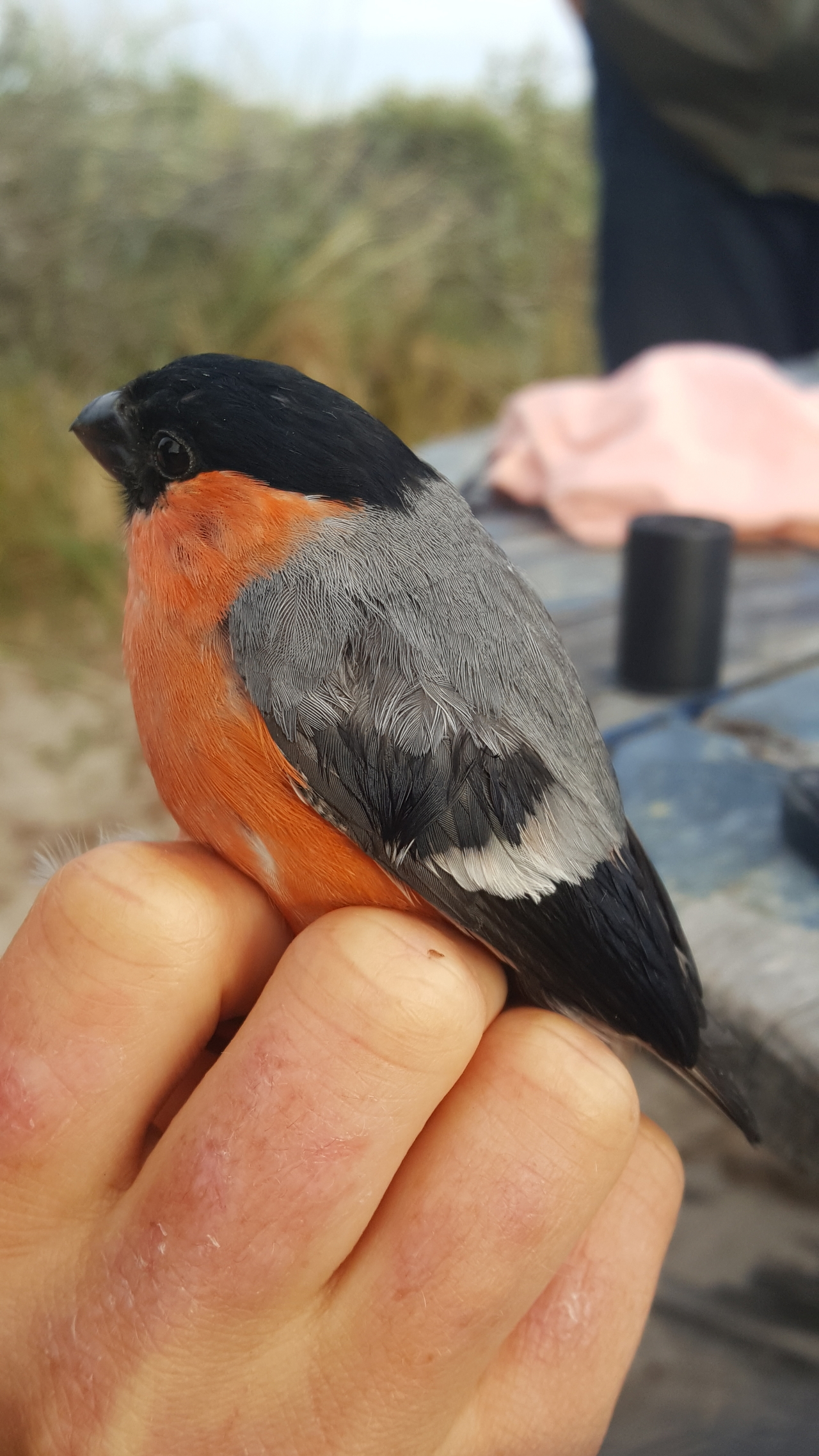 Bullfinch (Dompap)
Bullfinch (Dompap)
After the ringing session, Fanny and I went to check if eggs of previously known Common ringed plovers’ (Stor præstekrave) nests in Grenen beach had hatched, and we saw indeed some very young chicks running around with their parents. We decided to come back a bit later in the afternoon to catch the chicks and ring them. While ringing, the parents of the chicks were feigning having a broken wing (distraction display). This is a common strategy used by plovers to distract predators from attacking their chicks. We ringed two clutches of ringed plover, the first one with 3 chicks, the second one with 2.
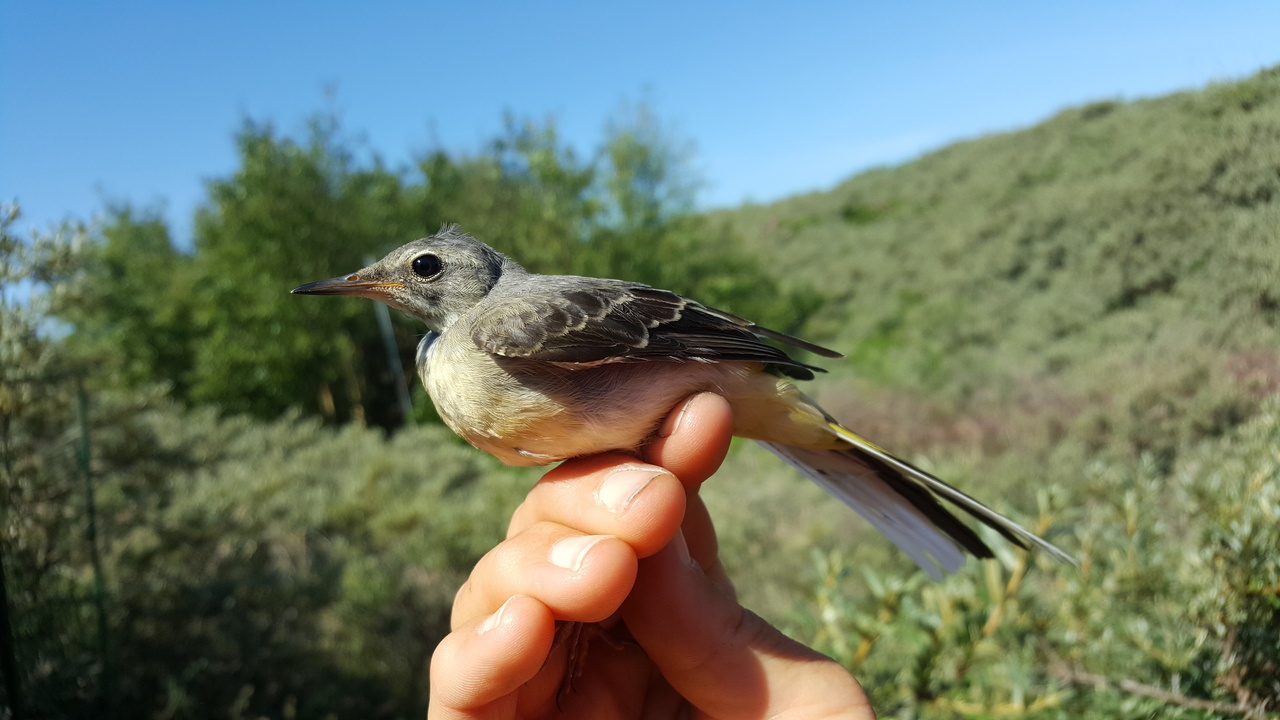 Female covering the chicks
Female covering the chicks

A very young chick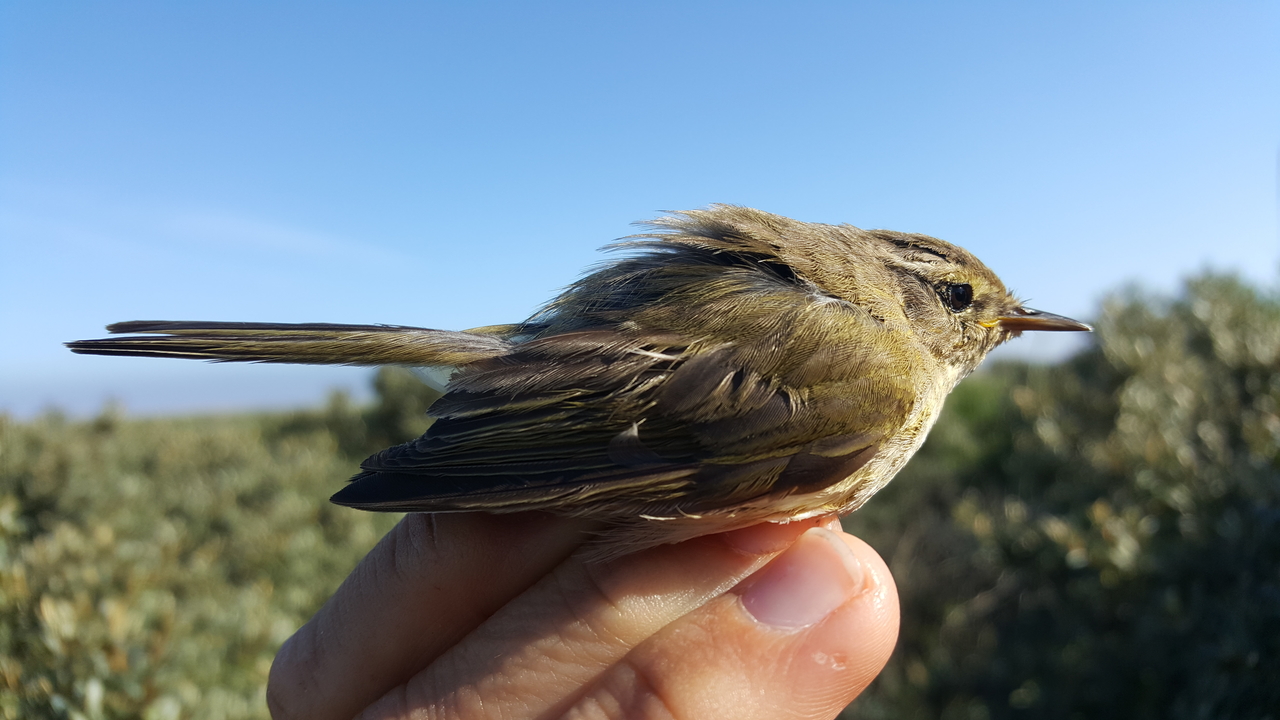
Weighing of the chicks
We ended the day by a nice dinner in a restaurant of Skagen, and then some bird watching in the fields around the town. We were looking for Rosy’s starlings (Rosenstær) but only saw Common starlings (Stær).
Ringing (Kabeltromlekrattet & Grenen beach):
Bogfinke - 1
Dompap, Lille (ssp. europaea) - 1
Tornsanger - 2
Havesanger - 1
Munk - 2
Gærdesmutte - 2
Rørsanger- 1
Gulbug - 1
Rødhals - 2
Gærdesanger - 1
Kærsanger - 2
Stor Præstekrave – 5
Lars Bo Jacobsen, Simon S. Christiansen, Fanny Rey, Frederik R. Johansen and Amandine Doré
Klik her for at se dagens observationer indtastet i Dofbasen af observatører i området
Klik her for at se opsummeret observationer af rovfugle i Skagen
Nightjar catching
Yesterday evening, we all went for some night-catching in Sandmiten, hoping to catch some Nightjars (Natravn). While setting up the nets, we started to hear some males singing, and saw at least three of them flying.
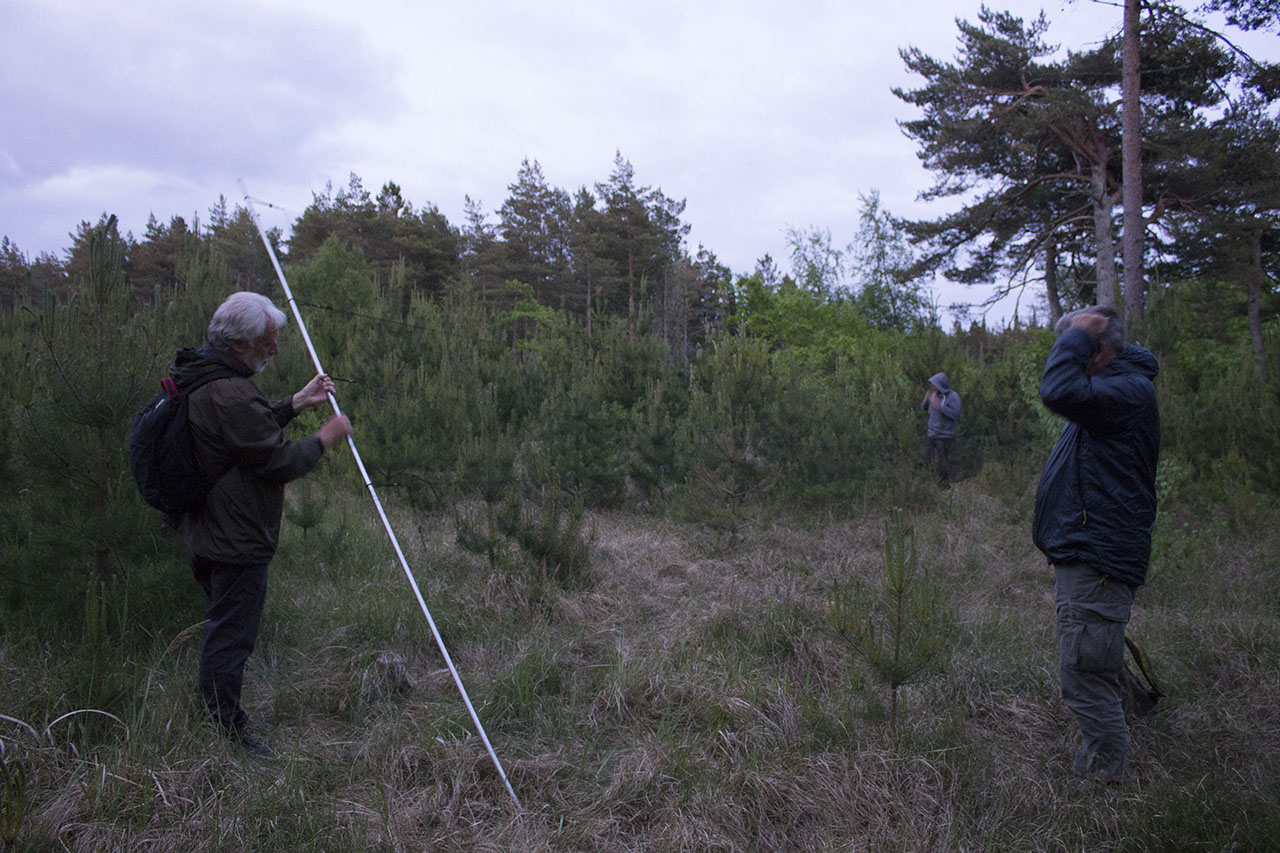
The weather conditions were good to catch nightjars – sky slightly cloudy and no wind – but unfortunately, after long hours waiting in the cold night and several rounds to the nets, no bird was caught… But we will probably try again soon!
During the night we also saw and heard several woodcocks flying over us. Other interesting fact, there was some faeces on the road, probably belonging to a wolf !
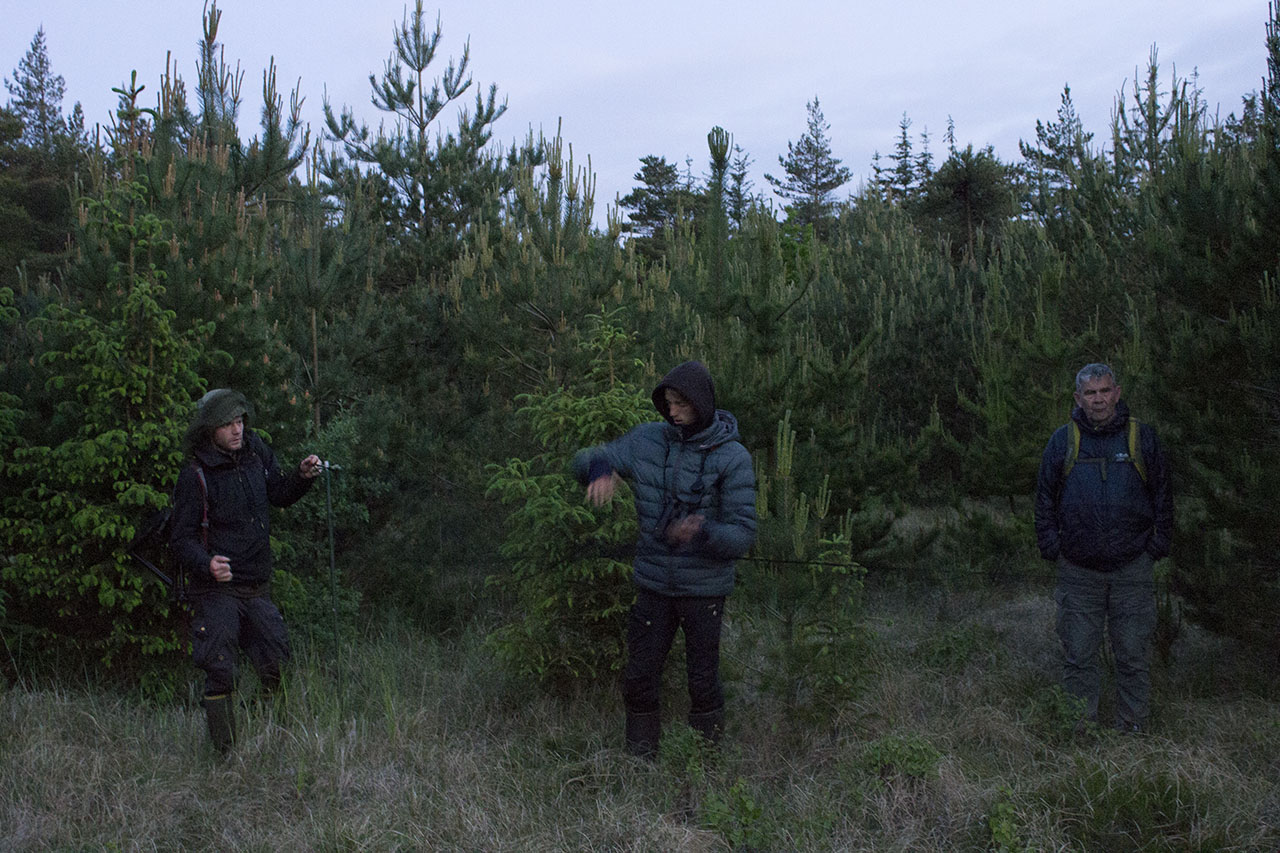
As the sun rose, we came back to the the Bird Observatory and Esben and I went out opening the nets at the Cable Drum Shrubbery. Fanny joined us some some time later, with some coffee that was definitely needed after this long night. The morning was very sunny and warm. Not many birds were caught, but we got a Reed Bunting (Rørspurv) and, in the last round, a young Crested tit (Topmejse)! Its an anually thing that the young Crested tits do dispersal here in June away from the breeding area while the adult stays.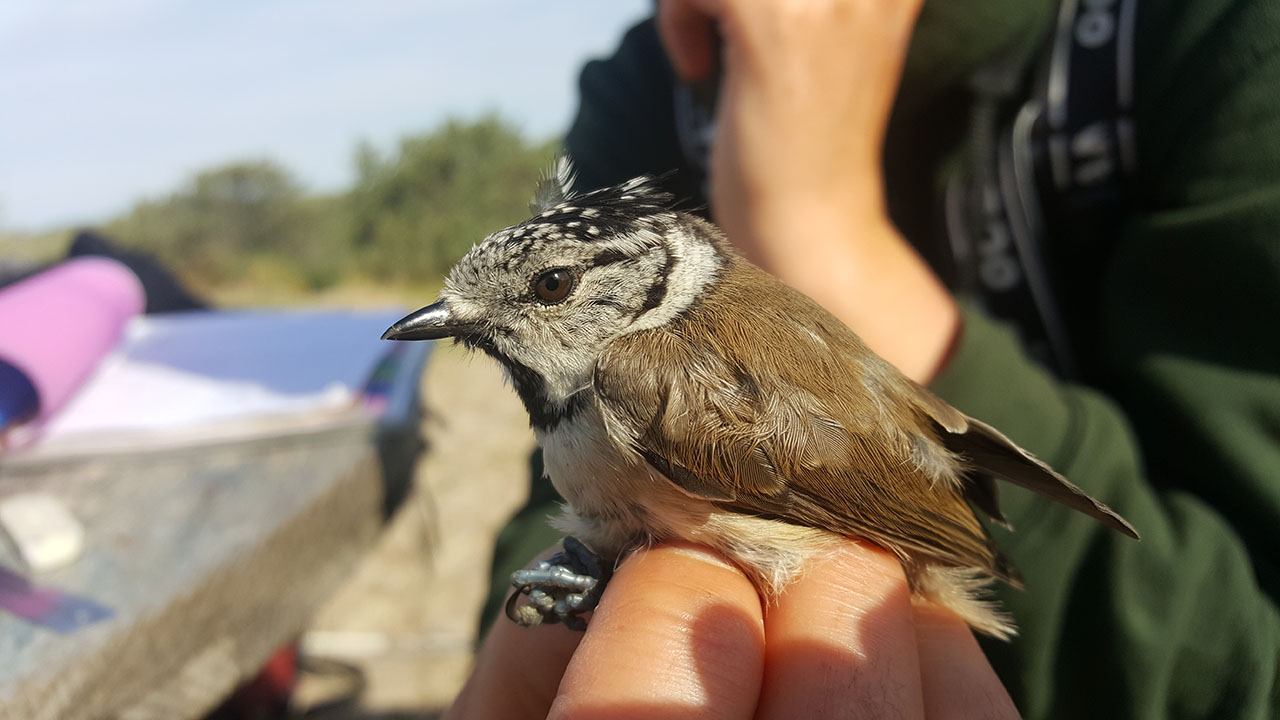
While waiting for the nets, we saw a Bittern (Rørdrum) flying around, heard and saw several Common Snipes (Dobbeltbekkasin).
Today was last day for Esben’s in the Observatory and he left after the ringing in the morning.
After dinner we went to the comorant lake in the evening, we did'nt see the Little Bittern but a nice Kingfisher was showing.
Ringing (Kabeltromlekrattet):
Gærdesmutte: 1
Rødstjert: 1
Kærsanger: 5
Rørsanger: 4
Gulbug: 1
Tornsanger: 3
Havesanger: 2
Munk: 4
Gransanger: 1
Topmejse: 1
Bogfinke: 2
Total: 24
Esben E. Hansen, Lars Bo Jacobsen,Simon S. Christiansen, Fanny Rey, Frederik R. Johansen, Pernille Roed and Amandine Doré
Klik her for at se dagens observationer indtastet i Dofbasen af observatører i området
Klik her for at se opsummeret observationer af rovfugle i Skagen
